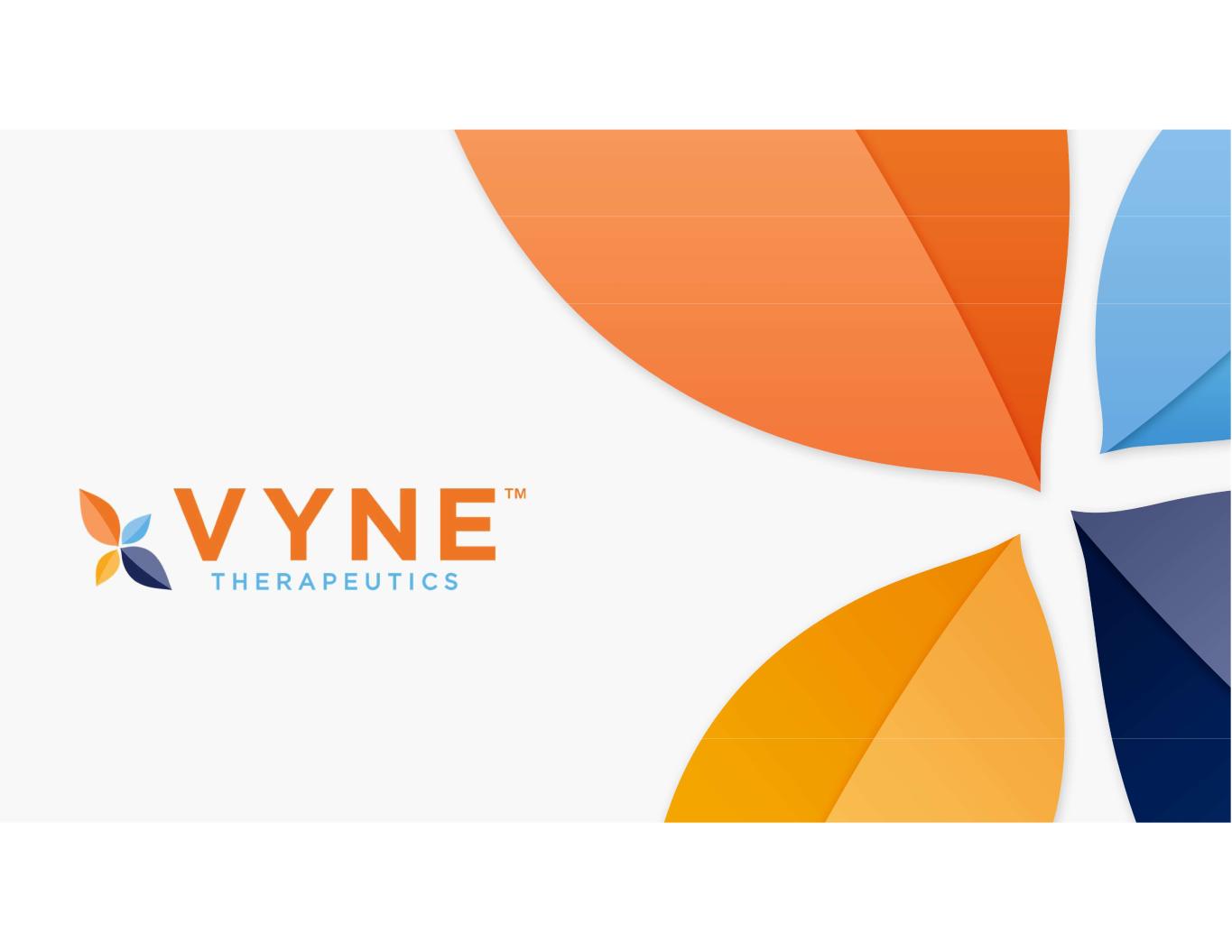Attached files
| file | filename |
|---|---|
| 8-K - 8-K - VYNE Therapeutics Inc. | mnlo-20210304.htm |
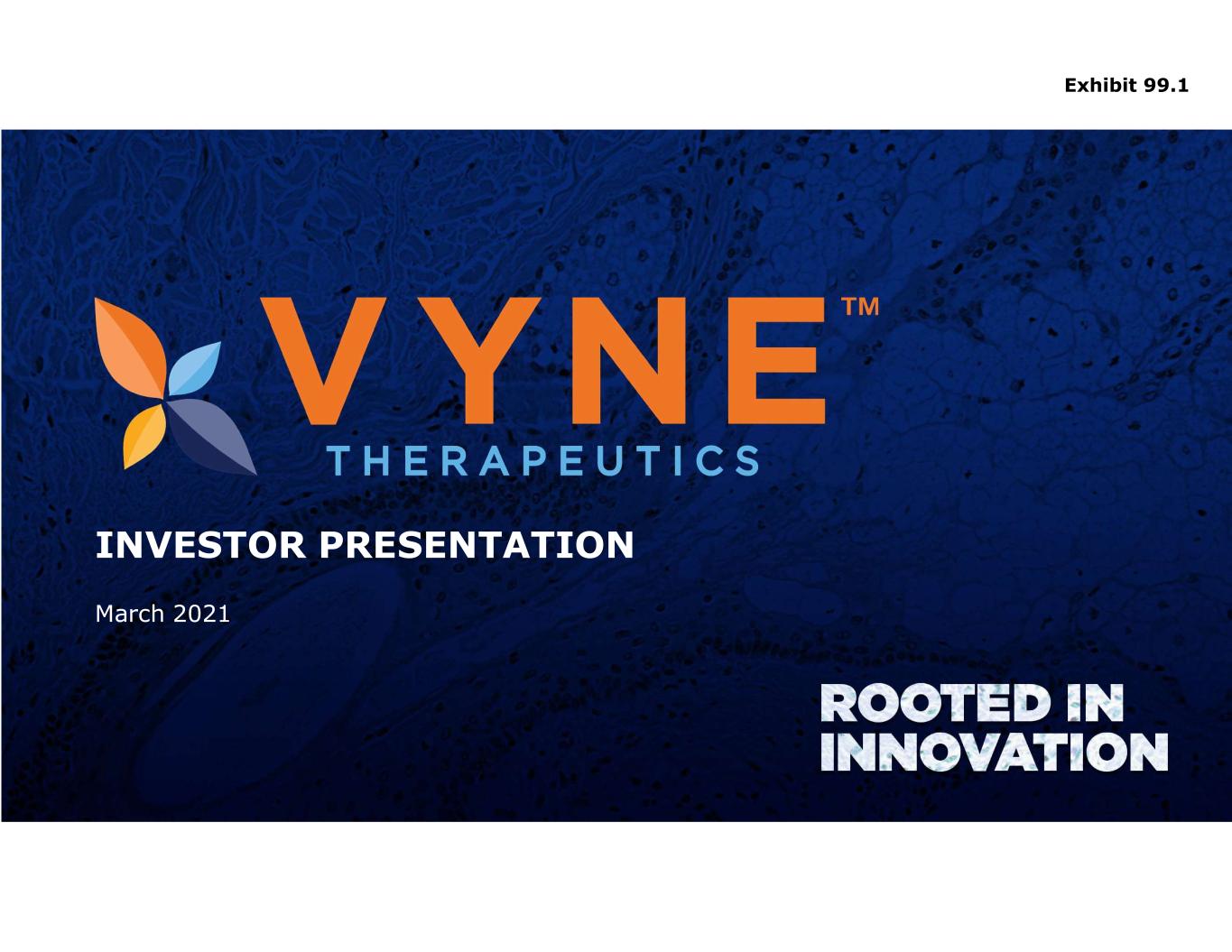
INVESTOR PRESENTATION March 2021 Exhibit 99.1
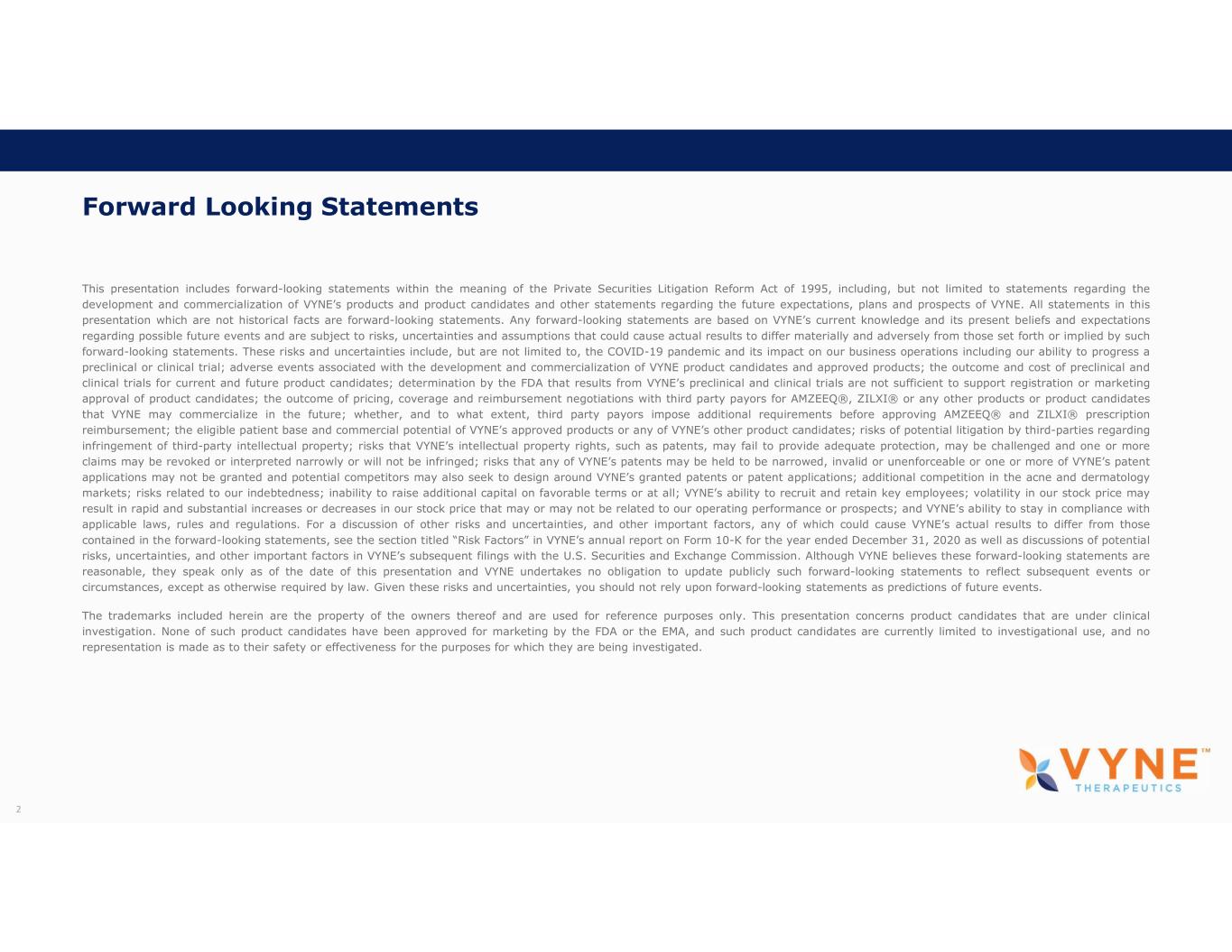
Forward Looking Statements 2 This presentation includes forward-looking statements within the meaning of the Private Securities Litigation Reform Act of 1995, including, but not limited to statements regarding the development and commercialization of VYNE’s products and product candidates and other statements regarding the future expectations, plans and prospects of VYNE. All statements in this presentation which are not historical facts are forward-looking statements. Any forward-looking statements are based on VYNE’s current knowledge and its present beliefs and expectations regarding possible future events and are subject to risks, uncertainties and assumptions that could cause actual results to differ materially and adversely from those set forth or implied by such forward-looking statements. These risks and uncertainties include, but are not limited to, the COVID-19 pandemic and its impact on our business operations including our ability to progress a preclinical or clinical trial; adverse events associated with the development and commercialization of VYNE product candidates and approved products; the outcome and cost of preclinical and clinical trials for current and future product candidates; determination by the FDA that results from VYNE’s preclinical and clinical trials are not sufficient to support registration or marketing approval of product candidates; the outcome of pricing, coverage and reimbursement negotiations with third party payors for AMZEEQ®, ZILXI® or any other products or product candidates that VYNE may commercialize in the future; whether, and to what extent, third party payors impose additional requirements before approving AMZEEQ® and ZILXI® prescription reimbursement; the eligible patient base and commercial potential of VYNE’s approved products or any of VYNE’s other product candidates; risks of potential litigation by third-parties regarding infringement of third-party intellectual property; risks that VYNE’s intellectual property rights, such as patents, may fail to provide adequate protection, may be challenged and one or more claims may be revoked or interpreted narrowly or will not be infringed; risks that any of VYNE’s patents may be held to be narrowed, invalid or unenforceable or one or more of VYNE’s patent applications may not be granted and potential competitors may also seek to design around VYNE’s granted patents or patent applications; additional competition in the acne and dermatology markets; risks related to our indebtedness; inability to raise additional capital on favorable terms or at all; VYNE’s ability to recruit and retain key employees; volatility in our stock price may result in rapid and substantial increases or decreases in our stock price that may or may not be related to our operating performance or prospects; and VYNE’s ability to stay in compliance with applicable laws, rules and regulations. For a discussion of other risks and uncertainties, and other important factors, any of which could cause VYNE’s actual results to differ from those contained in the forward-looking statements, see the section titled “Risk Factors” in VYNE’s annual report on Form 10-K for the year ended December 31, 2020 as well as discussions of potential risks, uncertainties, and other important factors in VYNE’s subsequent filings with the U.S. Securities and Exchange Commission. Although VYNE believes these forward-looking statements are reasonable, they speak only as of the date of this presentation and VYNE undertakes no obligation to update publicly such forward-looking statements to reflect subsequent events or circumstances, except as otherwise required by law. Given these risks and uncertainties, you should not rely upon forward-looking statements as predictions of future events. The trademarks included herein are the property of the owners thereof and are used for reference purposes only. This presentation concerns product candidates that are under clinical investigation. None of such product candidates have been approved for marketing by the FDA or the EMA, and such product candidates are currently limited to investigational use, and no representation is made as to their safety or effectiveness for the purposes for which they are being investigated.
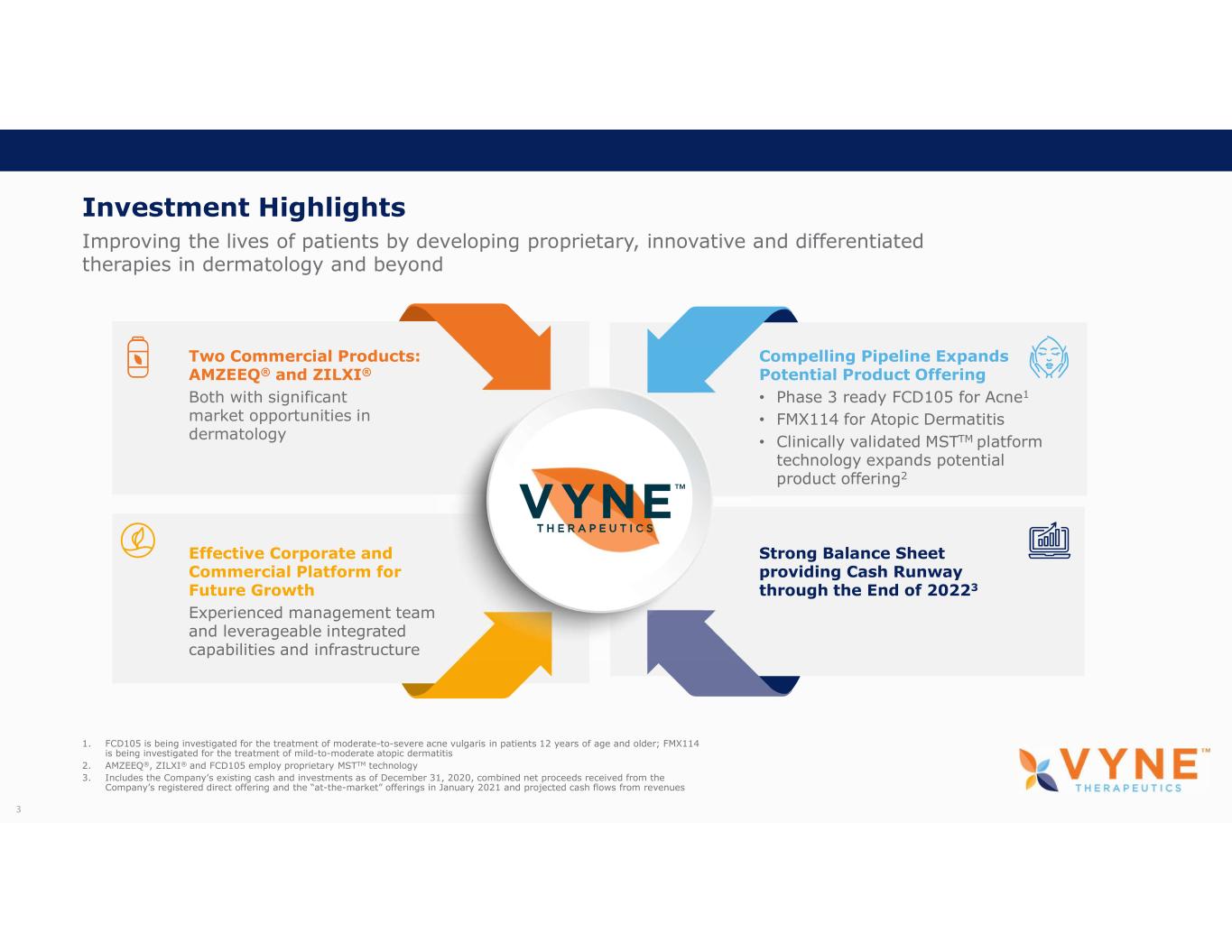
Investment Highlights Improving the lives of patients by developing proprietary, innovative and differentiated therapies in dermatology and beyond 1. FCD105 is being investigated for the treatment of moderate-to-severe acne vulgaris in patients 12 years of age and older; FMX114 is being investigated for the treatment of mild-to-moderate atopic dermatitis 2. AMZEEQ®, ZILXI® and FCD105 employ proprietary MSTTM technology 3. Includes the Company’s existing cash and investments as of December 31, 2020, combined net proceeds received from the Company’s registered direct offering and the “at-the-market” offerings in January 2021 and projected cash flows from revenues 3 Effective Corporate and Commercial Platform for Future Growth Experienced management team and leverageable integrated capabilities and infrastructure Two Commercial Products: AMZEEQ® and ZILXI® Both with significant market opportunities in dermatology Strong Balance Sheet providing Cash Runway through the End of 20223 Compelling Pipeline Expands Potential Product Offering • Phase 3 ready FCD105 for Acne1 • FMX114 for Atopic Dermatitis • Clinically validated MSTTM platform technology expands potential product offering2

Well Positioned To Deliver Significant Value Focused approach for 2021 Commercial Execution • Continue to progress trial and utilization of AMZEEQ® and ZILXI® • Drive market share growth Maximize Operational Leverage • Scalable corporate and commercial capabilities and infrastructure • Prudent resource prioritization and rationalization Build a Diversified Portfolio and Pipeline • Invest in internal R&D and corporate development efforts focused on clinically meaningful and differentiated products and product candidates 4 Long-term Value
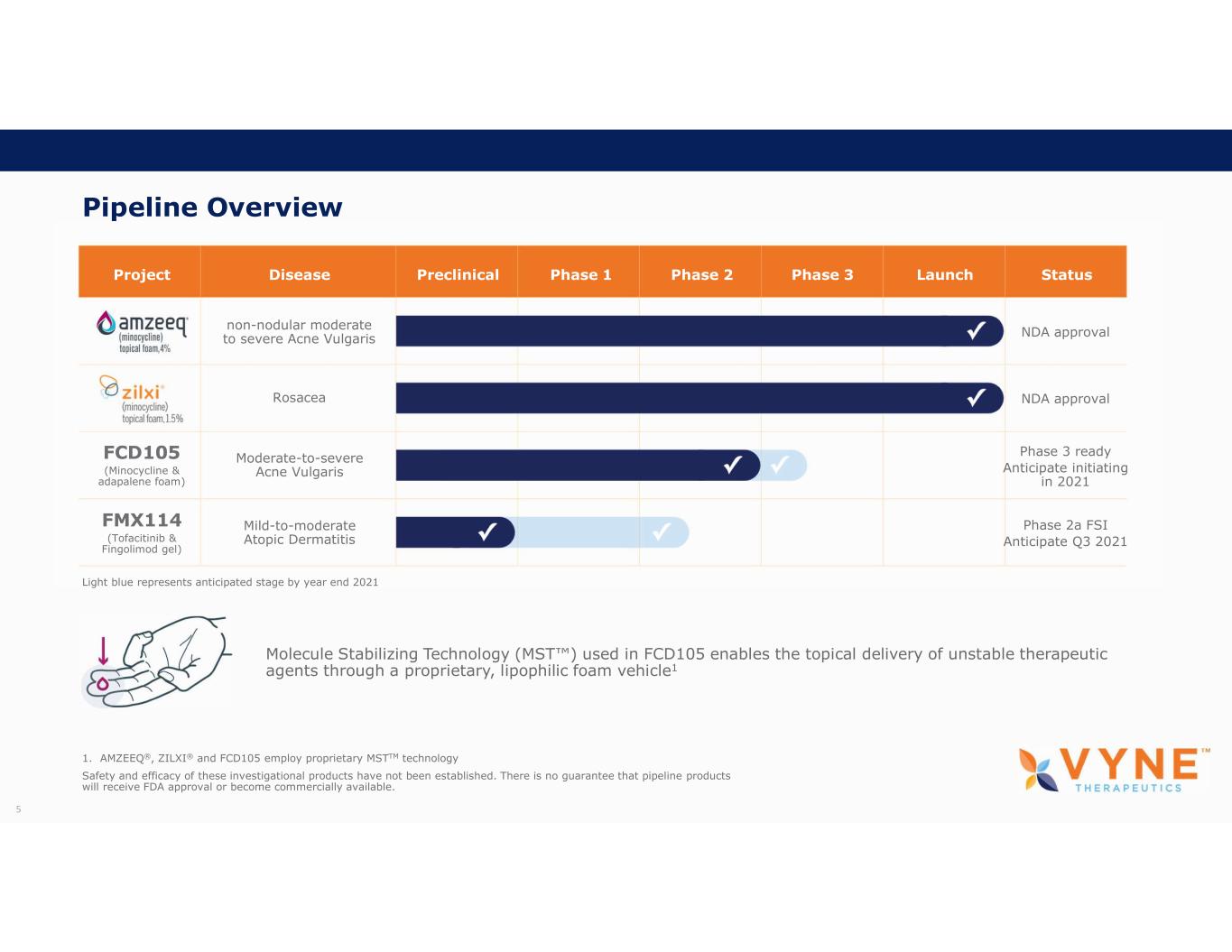
Pipeline Overview 1. AMZEEQ®, ZILXI® and FCD105 employ proprietary MSTTM technology Safety and efficacy of these investigational products have not been established. There is no guarantee that pipeline products will receive FDA approval or become commercially available. 5 Molecule Stabilizing Technology (MST™) used in FCD105 enables the topical delivery of unstable therapeutic agents through a proprietary, lipophilic foam vehicle1 Project Disease Preclinical Phase 1 Phase 2 Phase 3 Launch Status Rosacea non-nodular moderate to severe Acne Vulgaris NDA approval NDA approval FCD105 (Minocycline & adapalene foam) FMX114 (Tofacitinib & Fingolimod gel) Moderate-to-severe Acne Vulgaris Mild-to-moderate Atopic Dermatitis Phase 3 ready Anticipate initiating in 2021 Phase 2a FSI Anticipate Q3 2021 Light blue represents anticipated stage by year end 2021

COMMERCIAL OVERVIEW 6
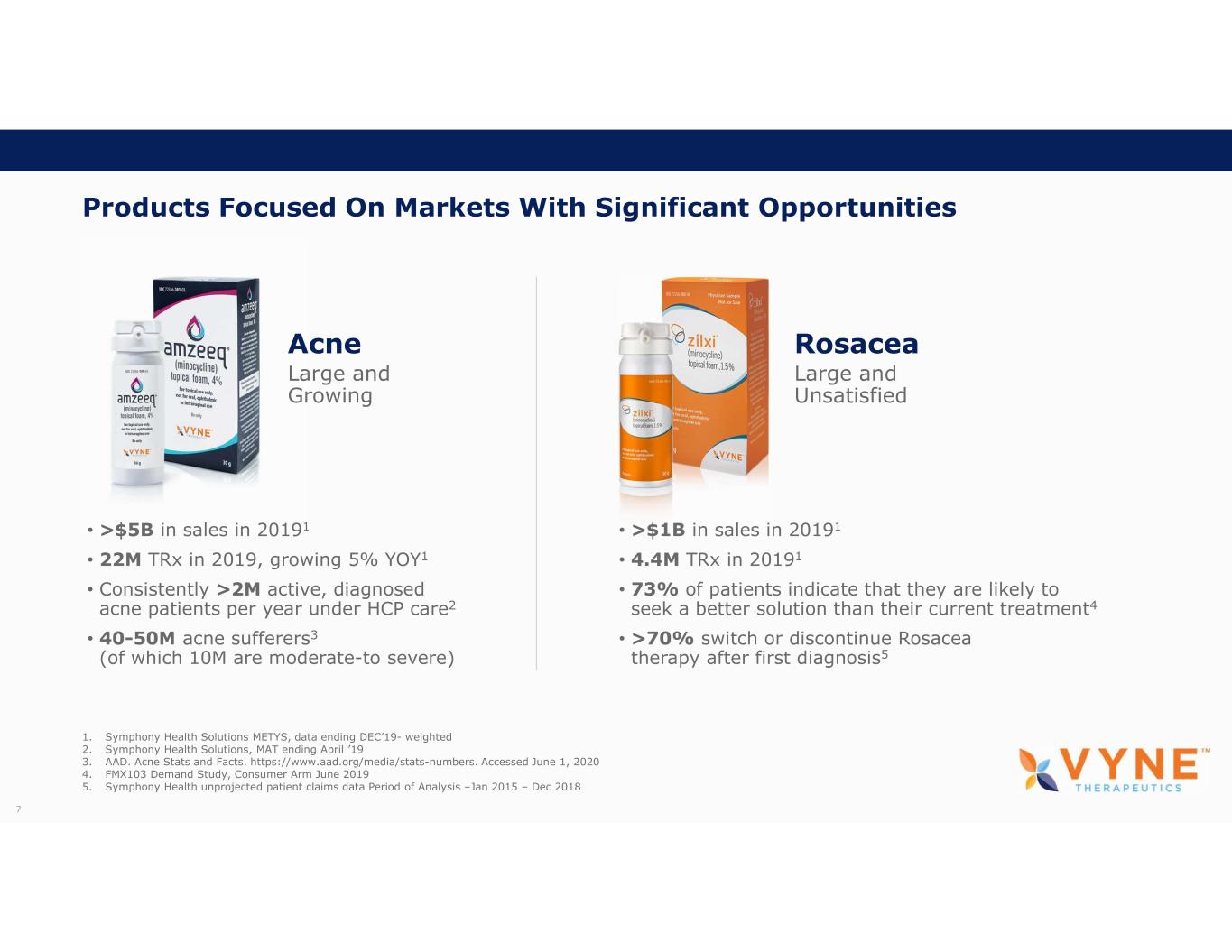
Products Focused On Markets With Significant Opportunities • >$5B in sales in 20191 • 22M TRx in 2019, growing 5% YOY1 • Consistently >2M active, diagnosed acne patients per year under HCP care2 • 40-50M acne sufferers3 (of which 10M are moderate-to severe) 1. Symphony Health Solutions METYS, data ending DEC’19- weighted 2. Symphony Health Solutions, MAT ending April ’19 3. AAD. Acne Stats and Facts. https://www.aad.org/media/stats-numbers. Accessed June 1, 2020 4. FMX103 Demand Study, Consumer Arm June 2019 5. Symphony Health unprojected patient claims data Period of Analysis –Jan 2015 – Dec 2018 7 Acne Large and Growing • >$1B in sales in 20191 • 4.4M TRx in 20191 • 73% of patients indicate that they are likely to seek a better solution than their current treatment4 • >70% switch or discontinue Rosacea therapy after first diagnosis5 Rosacea Large and Unsatisfied
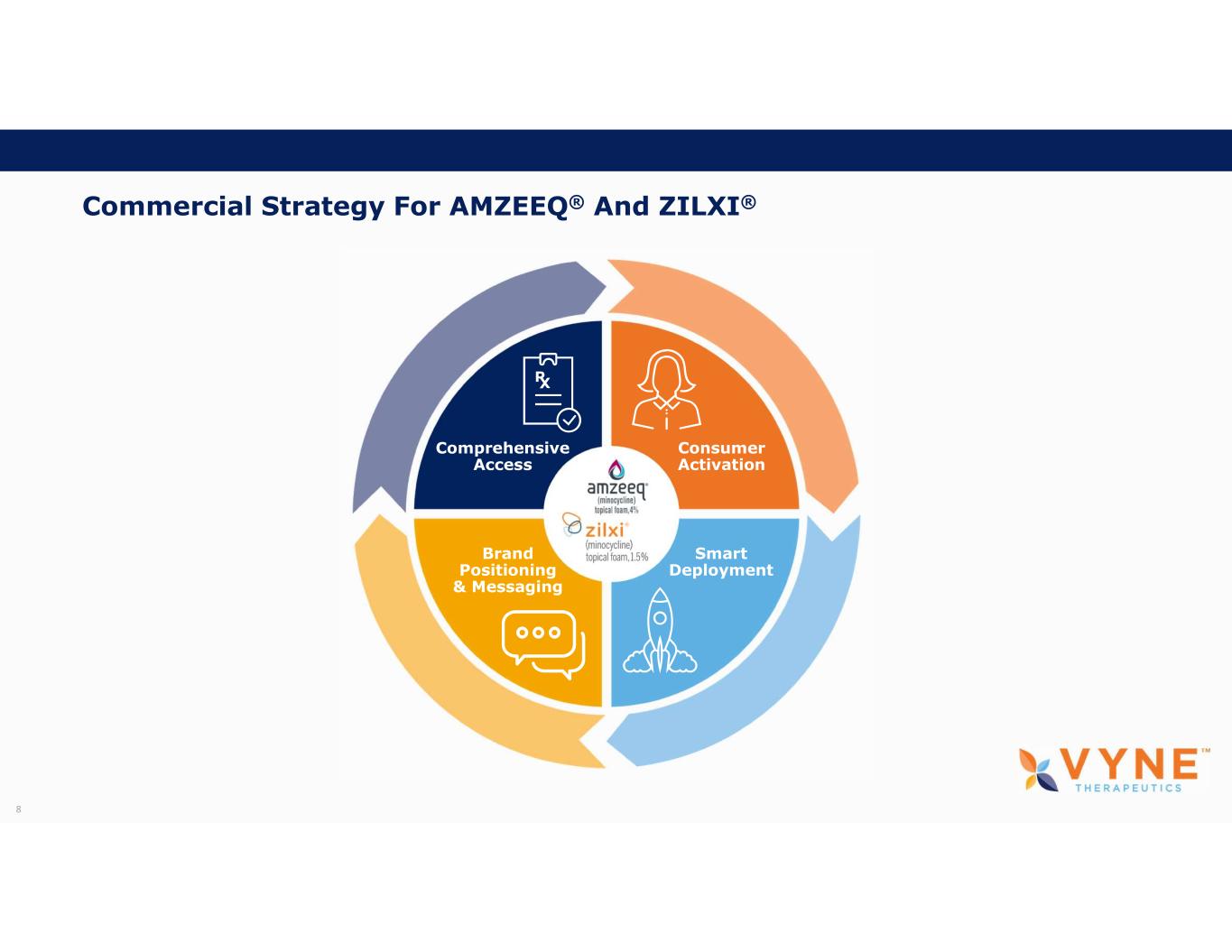
Commercial Strategy For AMZEEQ® And ZILXI® 8 Comprehensive Access Consumer Activation Brand Positioning & Messaging Smart Deployment
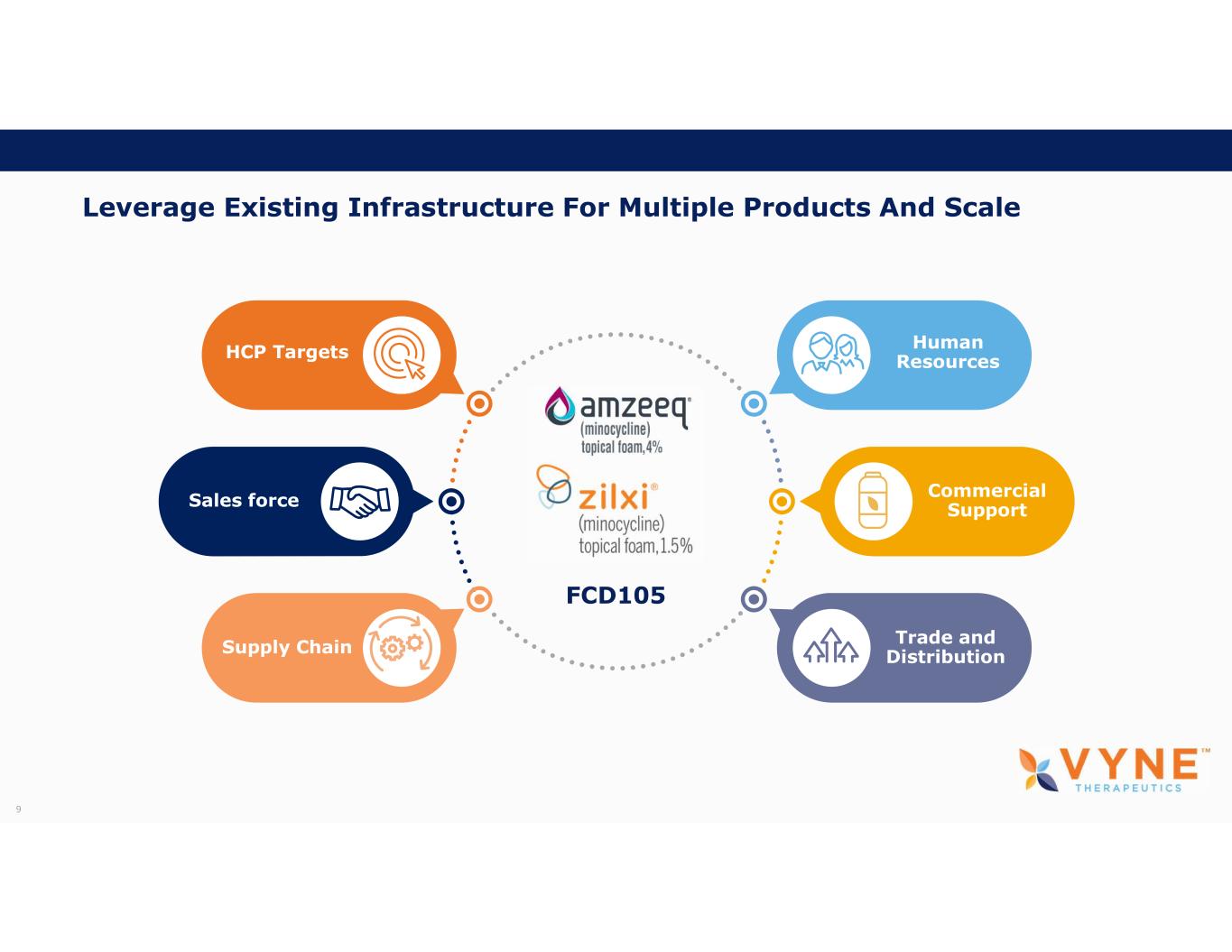
Leverage Existing Infrastructure For Multiple Products And Scale 9 FCD105 HCP Targets Sales force Commercial Support Supply Chain Trade and Distribution Human Resources

AMZEEQ® is indicated for the treatment of inflammatory lesions of non-nodular moderate to severe acne vulgaris in adults and pediatric patients 9 years of age and older. 10 Limitations of Use: This formulation of minocycline has not been evaluated in the treatment of infections. To reduce the development of drug-resistant bacteria as well as to maintain the effectiveness of other antibacterial drugs, AMZEEQ® should be used only as indicated. IMPORTANT SAFETY INFORMATION Contraindications: Persons who have shown hypersensitivity to any of the tetracyclines or any other ingredient in AMZEEQ® See slide 35 for Important Safety Information.
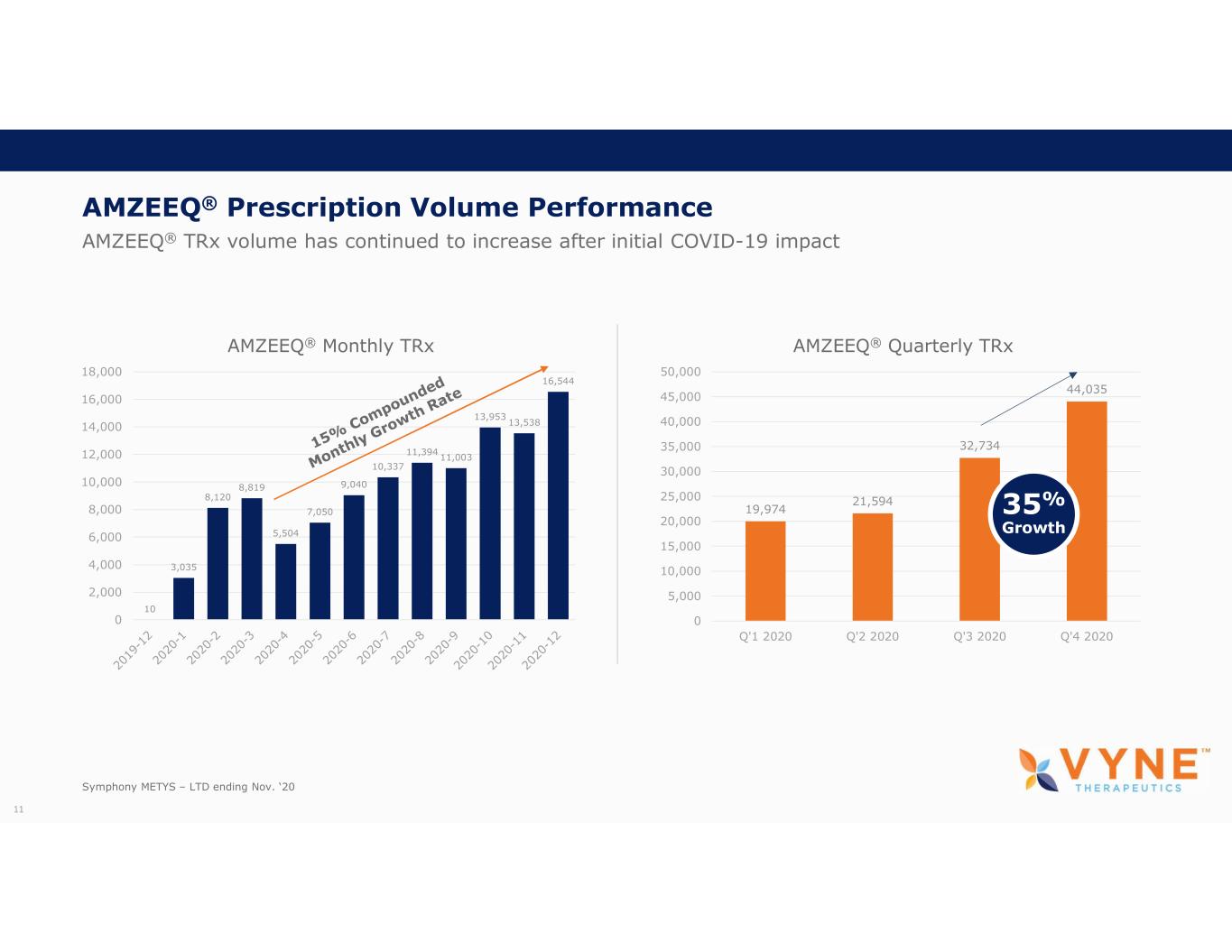
AMZEEQ® Prescription Volume Performance AMZEEQ® TRx volume has continued to increase after initial COVID-19 impact Symphony METYS – LTD ending Nov. ‘20 11 10 3,035 8,120 8,819 5,504 7,050 9,040 10,337 11,394 11,003 13,953 13,538 16,544 0 2,000 4,000 6,000 8,000 10,000 12,000 14,000 16,000 18,000 AMZEEQ® Monthly TRx 19,974 21,594 32,734 44,035 0 5,000 10,000 15,000 20,000 25,000 30,000 35,000 40,000 45,000 50,000 Q'1 2020 Q'2 2020 Q'3 2020 Q'4 2020 AMZEEQ® Quarterly TRx 35% Growth

AMZEEQ® Unique Prescribers AMZEEQ® continues to attract new unique prescribers each week, eclipsing 7,000 total since launch and averaging between 1,500-1,600 unique weekly prescribers. Source: Symphony Vantage Prescriber Insights, February 2021. 12 - 1,000 2,000 3,000 4,000 5,000 6,000 7,000 8,000 Total AMZEEQ® Prescribers Launch-to-Date 0 200 400 600 800 1,000 1,200 1,400 1,600 1,800 Weekly Unique Prescribers
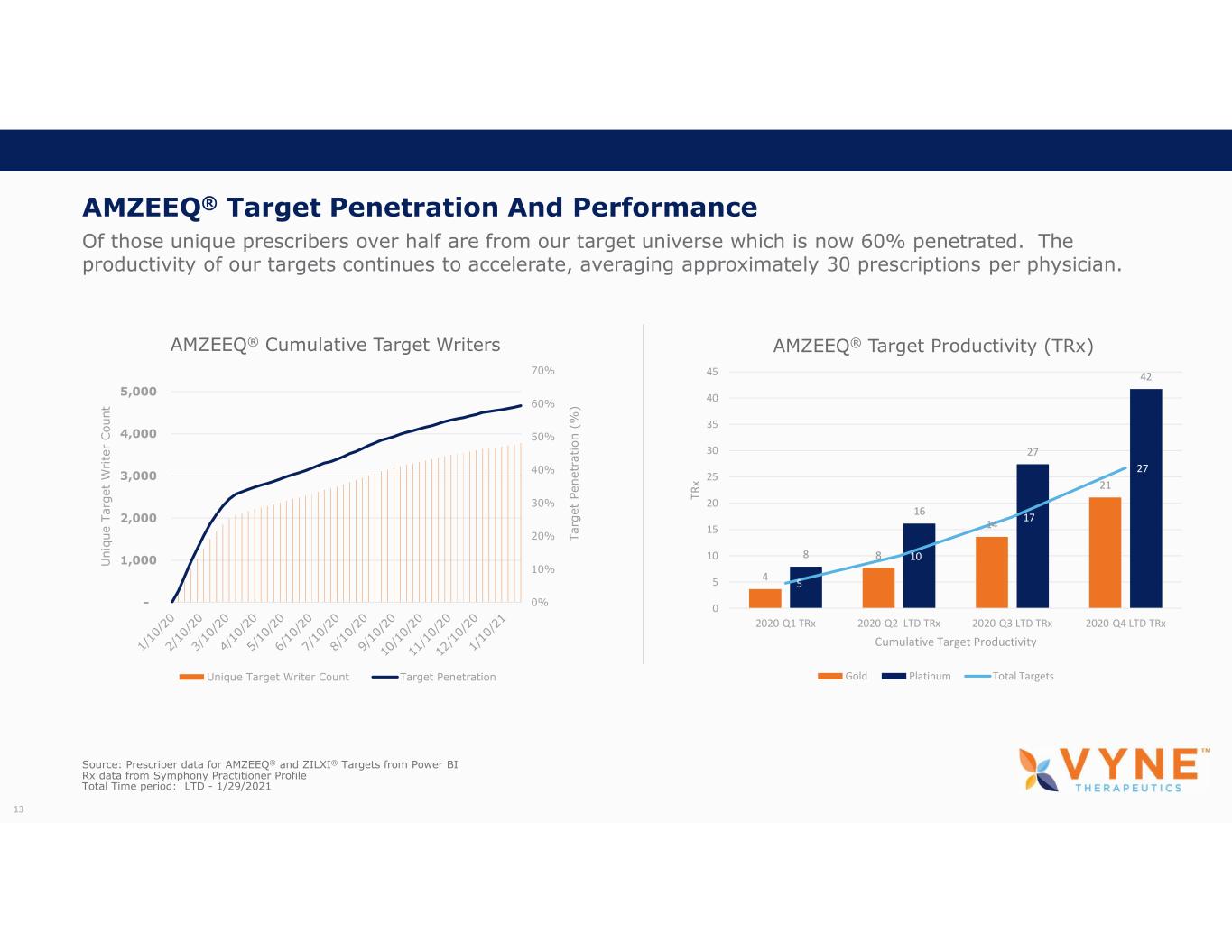
AMZEEQ® Target Penetration And Performance Of those unique prescribers over half are from our target universe which is now 60% penetrated. The productivity of our targets continues to accelerate, averaging approximately 30 prescriptions per physician. Source: Prescriber data for AMZEEQ® and ZILXI® Targets from Power BI Rx data from Symphony Practitioner Profile Total Time period: LTD - 1/29/2021 13 0% 10% 20% 30% 40% 50% 60% 70% - 1,000 2,000 3,000 4,000 5,000 T a rg e t P e n e tr a ti o n ( % ) U n iq u e T a rg e t W ri te r C o u n t AMZEEQ® Cumulative Target Writers Unique Target Writer Count Target Penetration 4 8 14 21 8 16 27 42 5 10 17 27 0 5 10 15 20 25 30 35 40 45 2020-Q1 TRx 2020-Q2 LTD TRx 2020-Q3 LTD TRx 2020-Q4 LTD TRx TR x Cumulative Target Productivity AMZEEQ® Target Productivity (TRx) Gold Platinum Total Targets
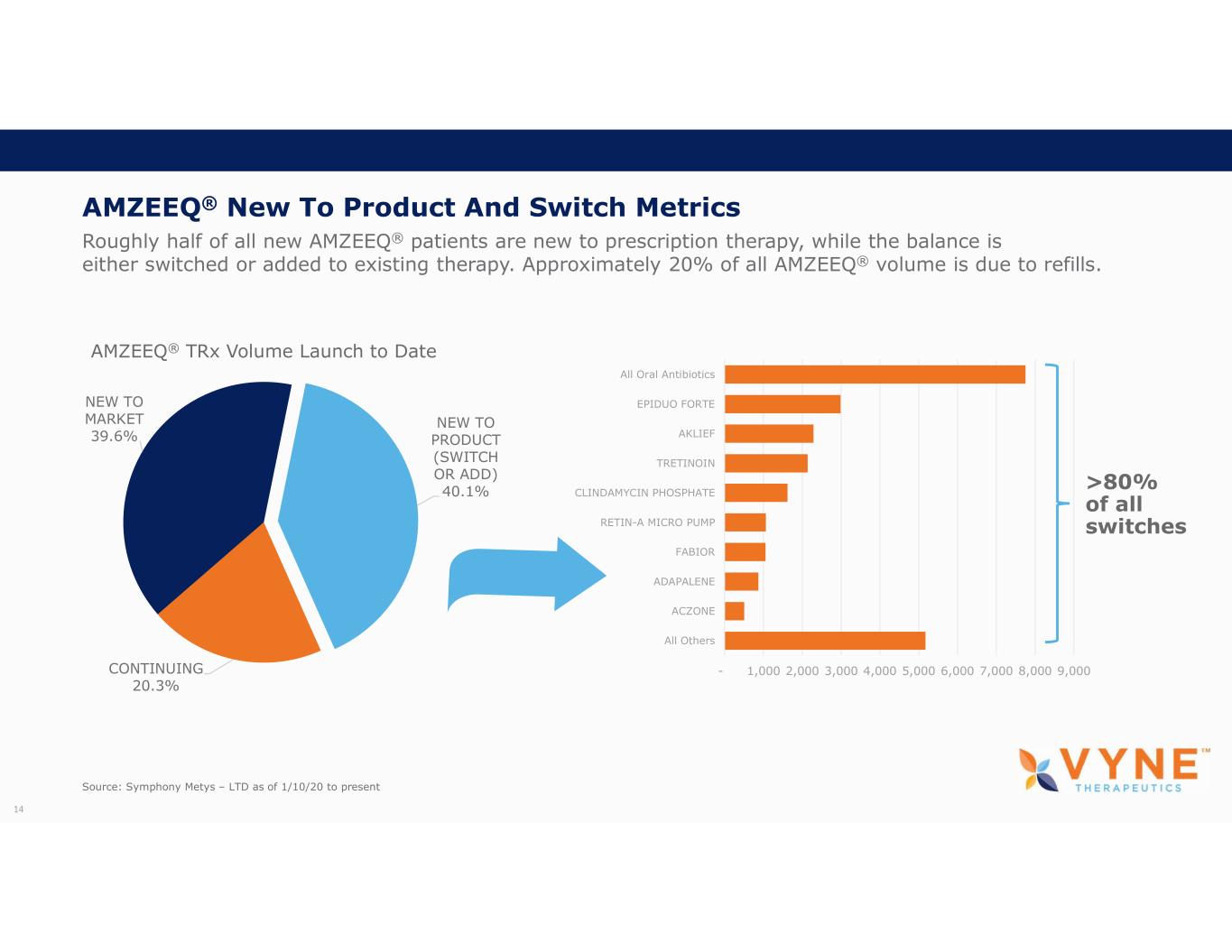
AMZEEQ® New To Product And Switch Metrics Roughly half of all new AMZEEQ® patients are new to prescription therapy, while the balance is either switched or added to existing therapy. Approximately 20% of all AMZEEQ® volume is due to refills. 14 CONTINUING 20.3% NEW TO MARKET 39.6% NEW TO PRODUCT (SWITCH OR ADD) 40.1% - 1,000 2,000 3,000 4,000 5,000 6,000 7,000 8,000 9,000 All Others ACZONE ADAPALENE FABIOR RETIN-A MICRO PUMP CLINDAMYCIN PHOSPHATE TRETINOIN AKLIEF EPIDUO FORTE All Oral Antibiotics >80% of all switches AMZEEQ® TRx Volume Launch to Date Source: Symphony Metys – LTD as of 1/10/20 to present
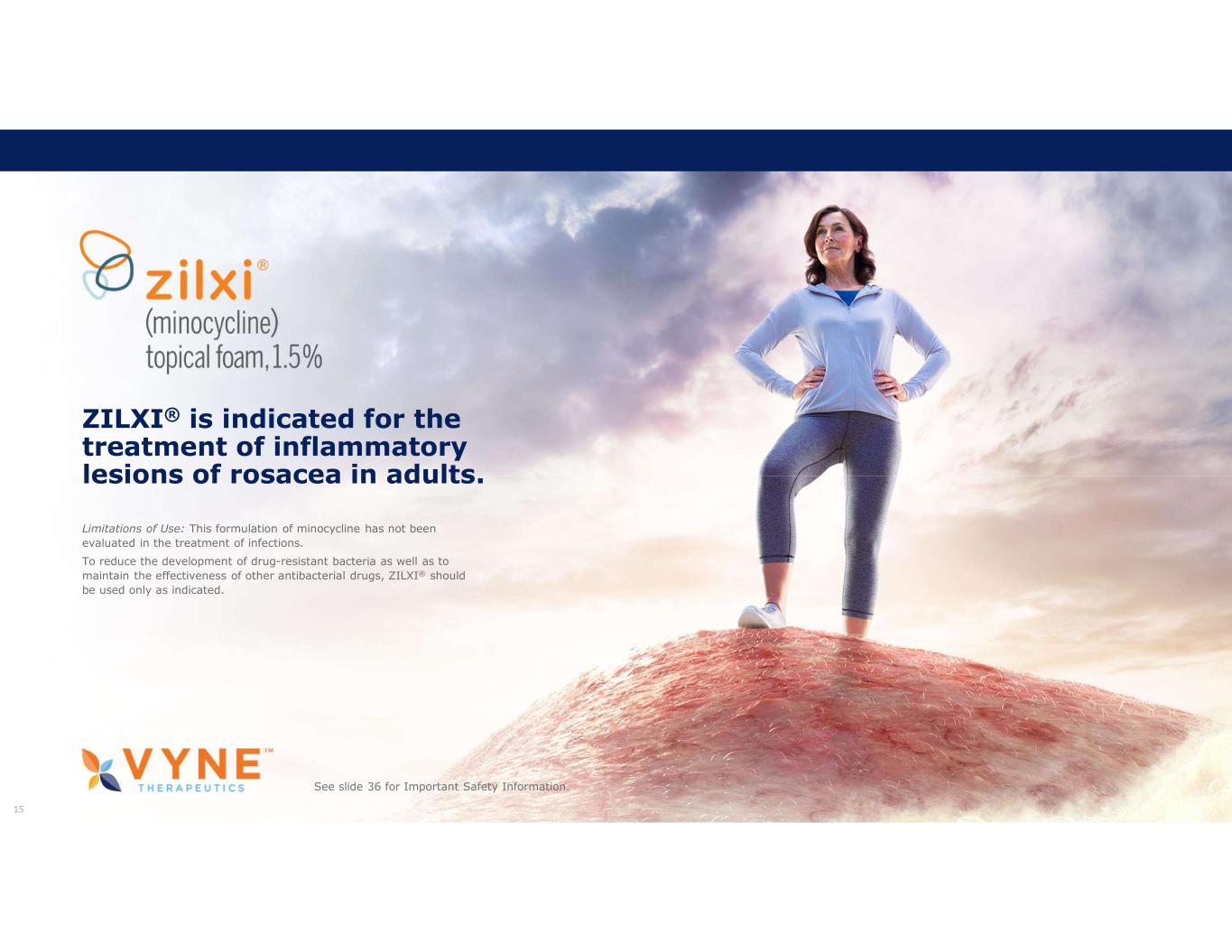
15 ZILXI® is indicated for the treatment of inflammatory lesions of rosacea in adults. See slide 36 for Important Safety Information. Limitations of Use: This formulation of minocycline has not been evaluated in the treatment of infections. To reduce the development of drug-resistant bacteria as well as to maintain the effectiveness of other antibacterial drugs, ZILXI® should be used only as indicated.
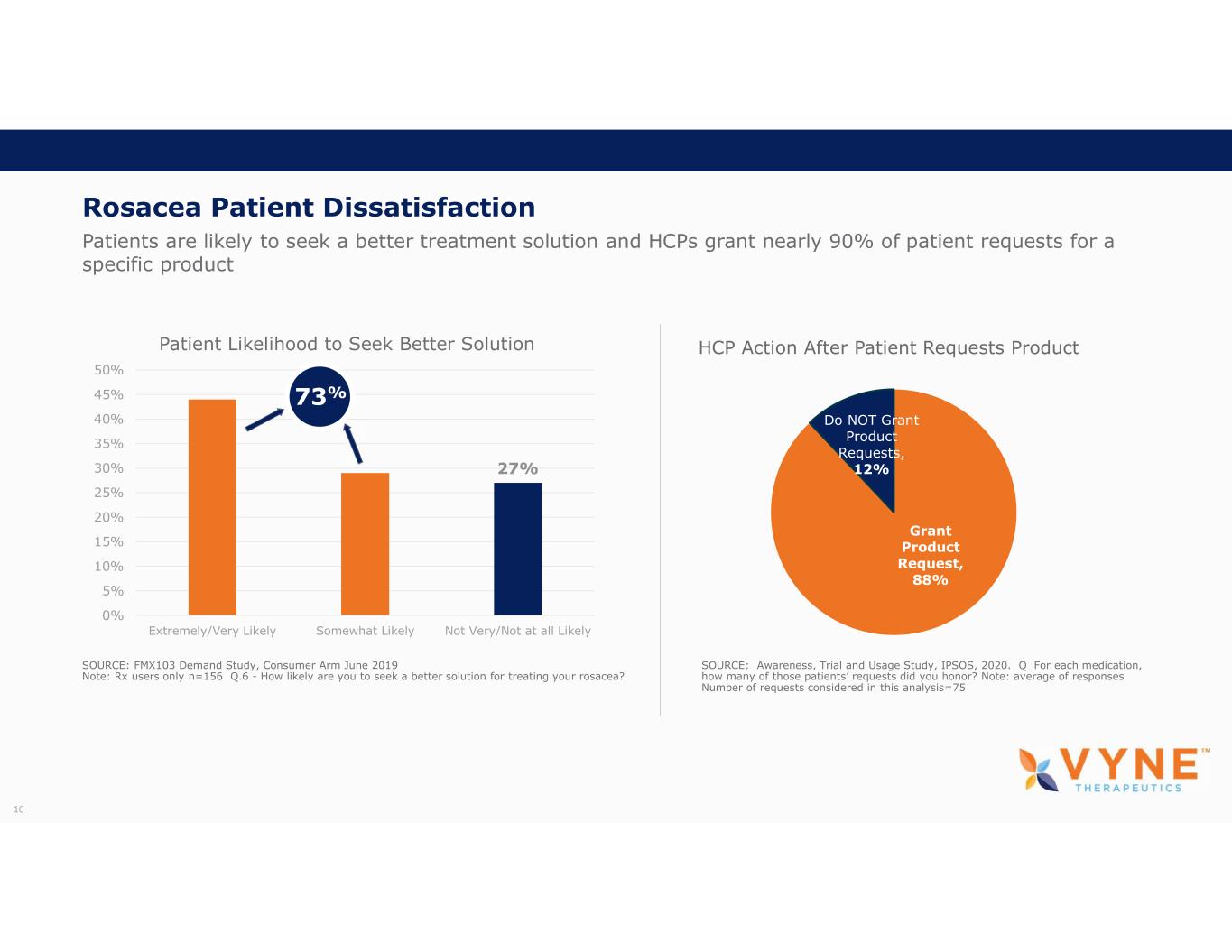
Rosacea Patient Dissatisfaction Patients are likely to seek a better treatment solution and HCPs grant nearly 90% of patient requests for a specific product SOURCE: FMX103 Demand Study, Consumer Arm June 2019 Note: Rx users only n=156 Q.6 - How likely are you to seek a better solution for treating your rosacea? 16 SOURCE: Awareness, Trial and Usage Study, IPSOS, 2020. Q For each medication, how many of those patients’ requests did you honor? Note: average of responses Number of requests considered in this analysis=75 Grant Product Request, 88% Do NOT Grant Product Requests, 12% HCP Action After Patient Requests Product 27% 0% 5% 10% 15% 20% 25% 30% 35% 40% 45% 50% Extremely/Very Likely Somewhat Likely Not Very/Not at all Likely Patient Likelihood to Seek Better Solution 73%
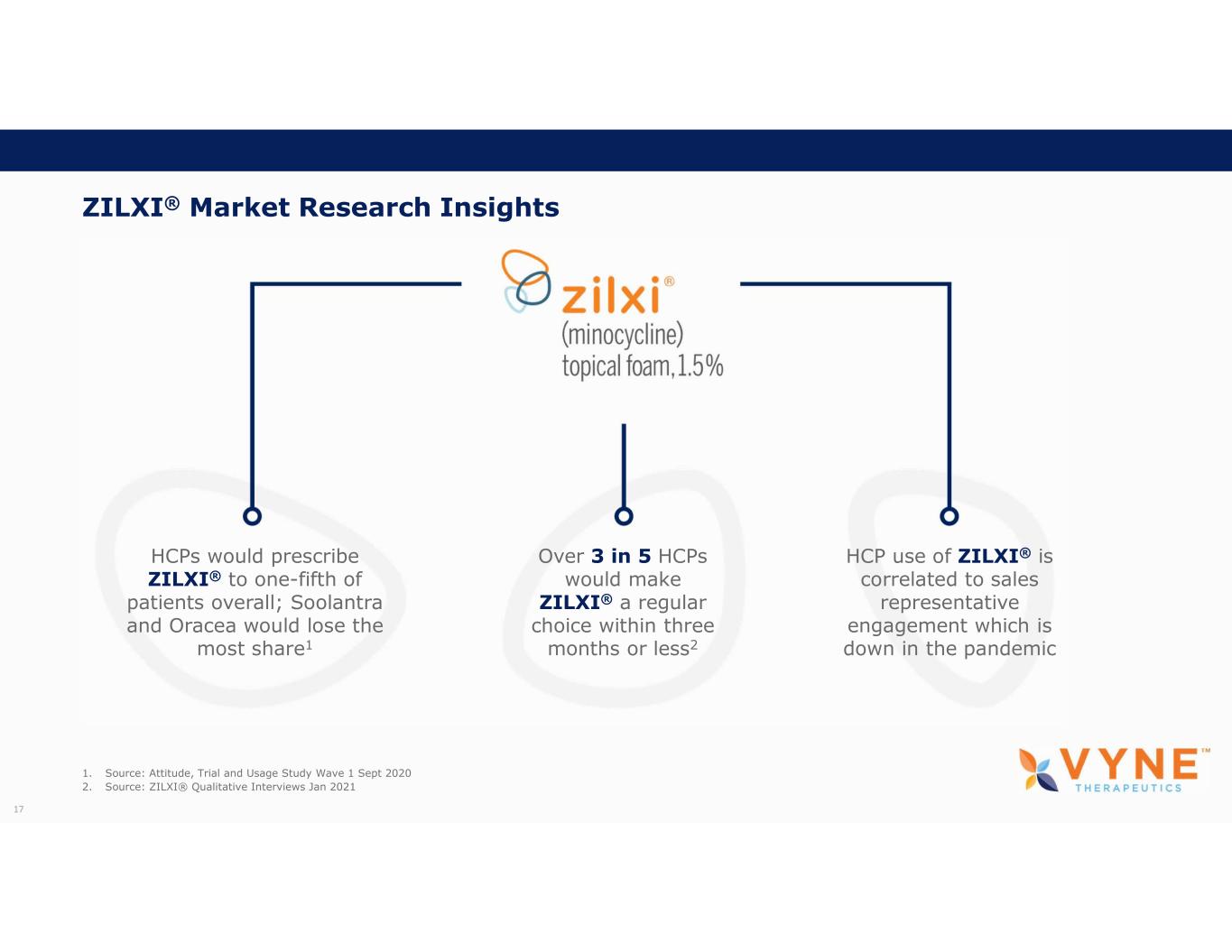
ZILXI® Market Research Insights 1. Source: Attitude, Trial and Usage Study Wave 1 Sept 2020 2. Source: ZILXI® Qualitative Interviews Jan 2021 17 HCPs would prescribe ZILXI® to one-fifth of patients overall; Soolantra and Oracea would lose the most share1 Over 3 in 5 HCPs would make ZILXI® a regular choice within three months or less2 HCP use of ZILXI® is correlated to sales representative engagement which is down in the pandemic
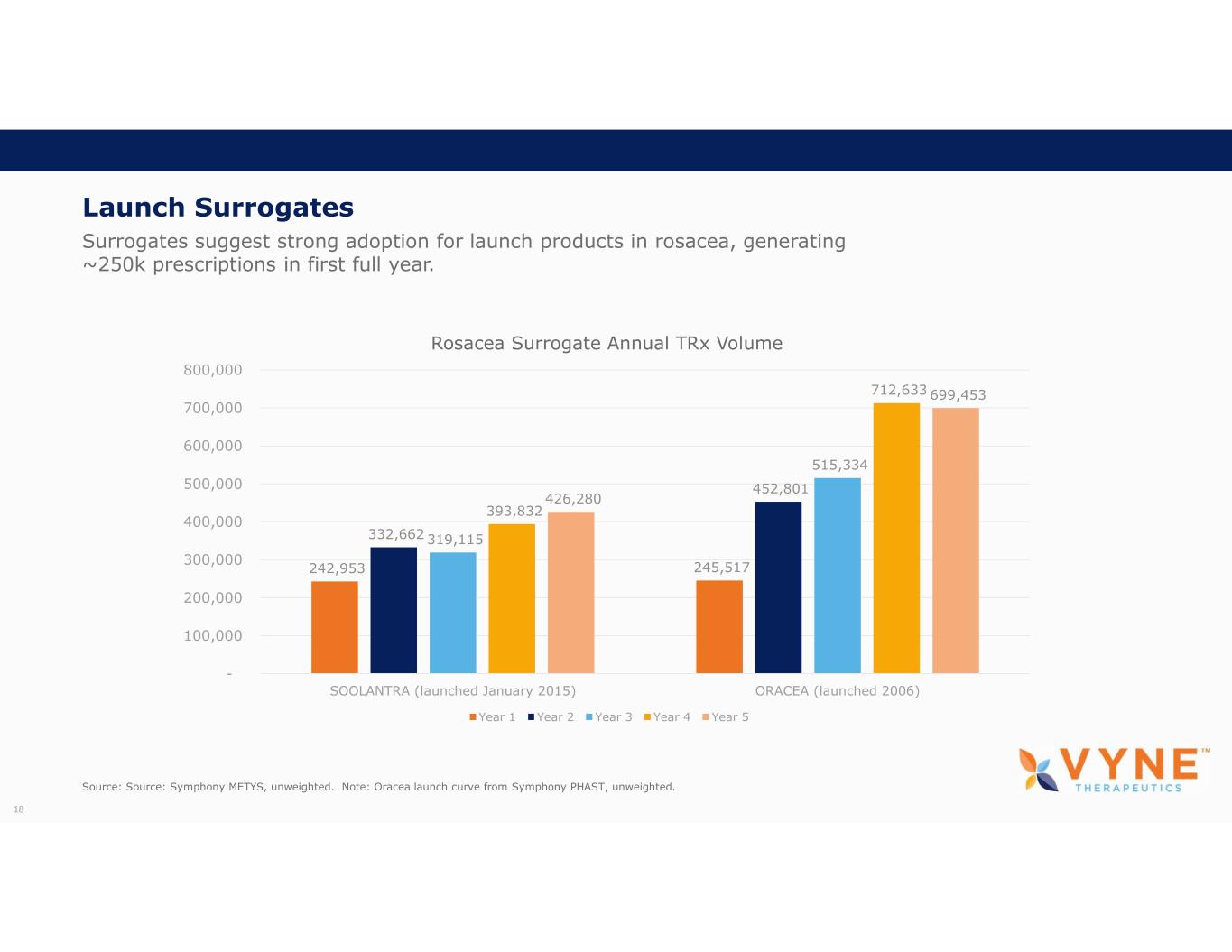
Launch Surrogates Surrogates suggest strong adoption for launch products in rosacea, generating ~250k prescriptions in first full year. Source: Source: Symphony METYS, unweighted. Note: Oracea launch curve from Symphony PHAST, unweighted. 18 242,953 245,517 332,662 452,801 319,115 515,334 393,832 712,633 426,280 699,453 - 100,000 200,000 300,000 400,000 500,000 600,000 700,000 800,000 SOOLANTRA (launched January 2015) ORACEA (launched 2006) Rosacea Surrogate Annual TRx Volume Year 1 Year 2 Year 3 Year 4 Year 5
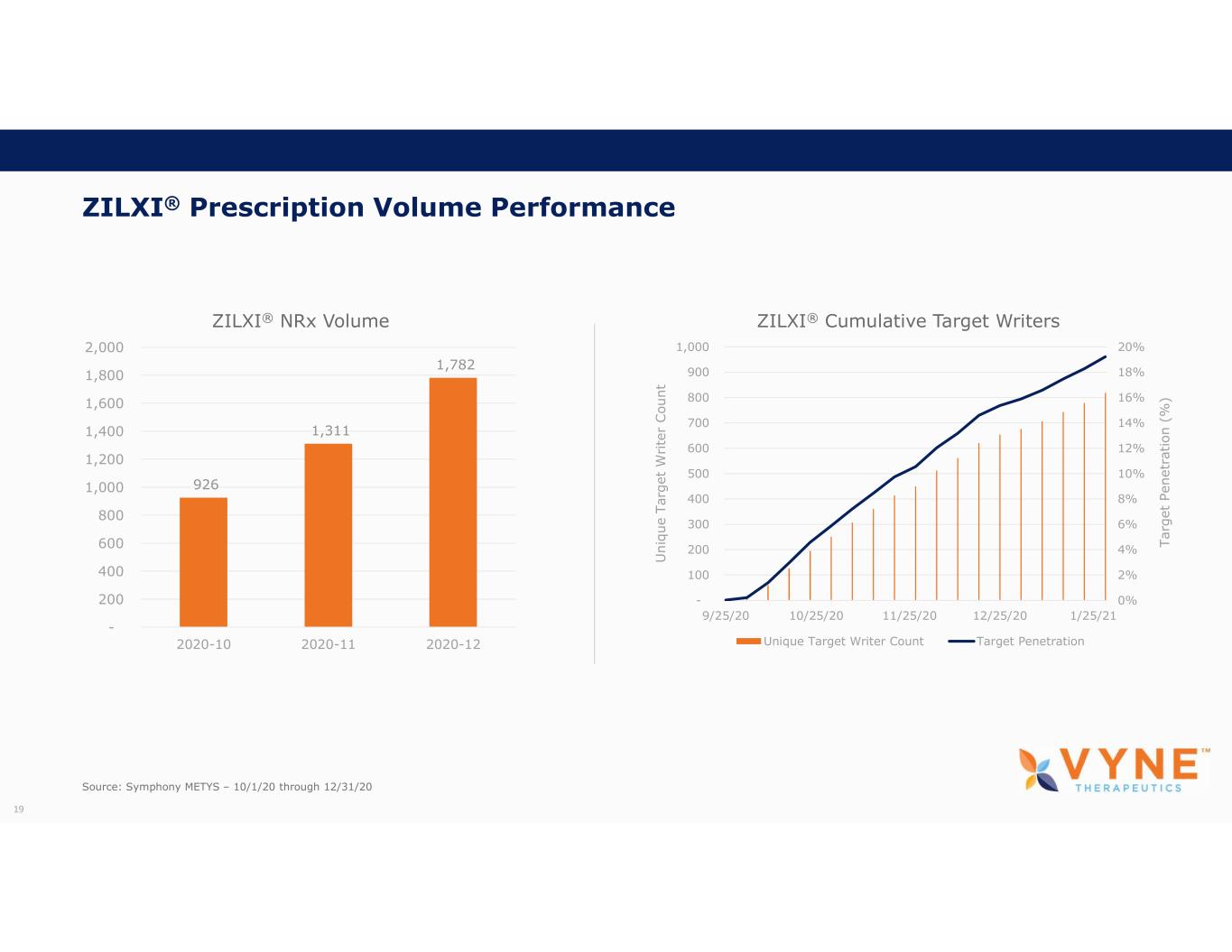
ZILXI® Prescription Volume Performance Source: Symphony METYS – 10/1/20 through 12/31/20 19 926 1,311 1,782 - 200 400 600 800 1,000 1,200 1,400 1,600 1,800 2,000 2020-10 2020-11 2020-12 ZILXI® NRx Volume 0% 2% 4% 6% 8% 10% 12% 14% 16% 18% 20% - 100 200 300 400 500 600 700 800 900 1,000 9/25/20 10/25/20 11/25/20 12/25/20 1/25/21 T a rg e t P e n e tr a ti o n ( % ) U n iq u e T a rg e t W ri te r C o u n t ZILXI® Cumulative Target Writers Unique Target Writer Count Target Penetration
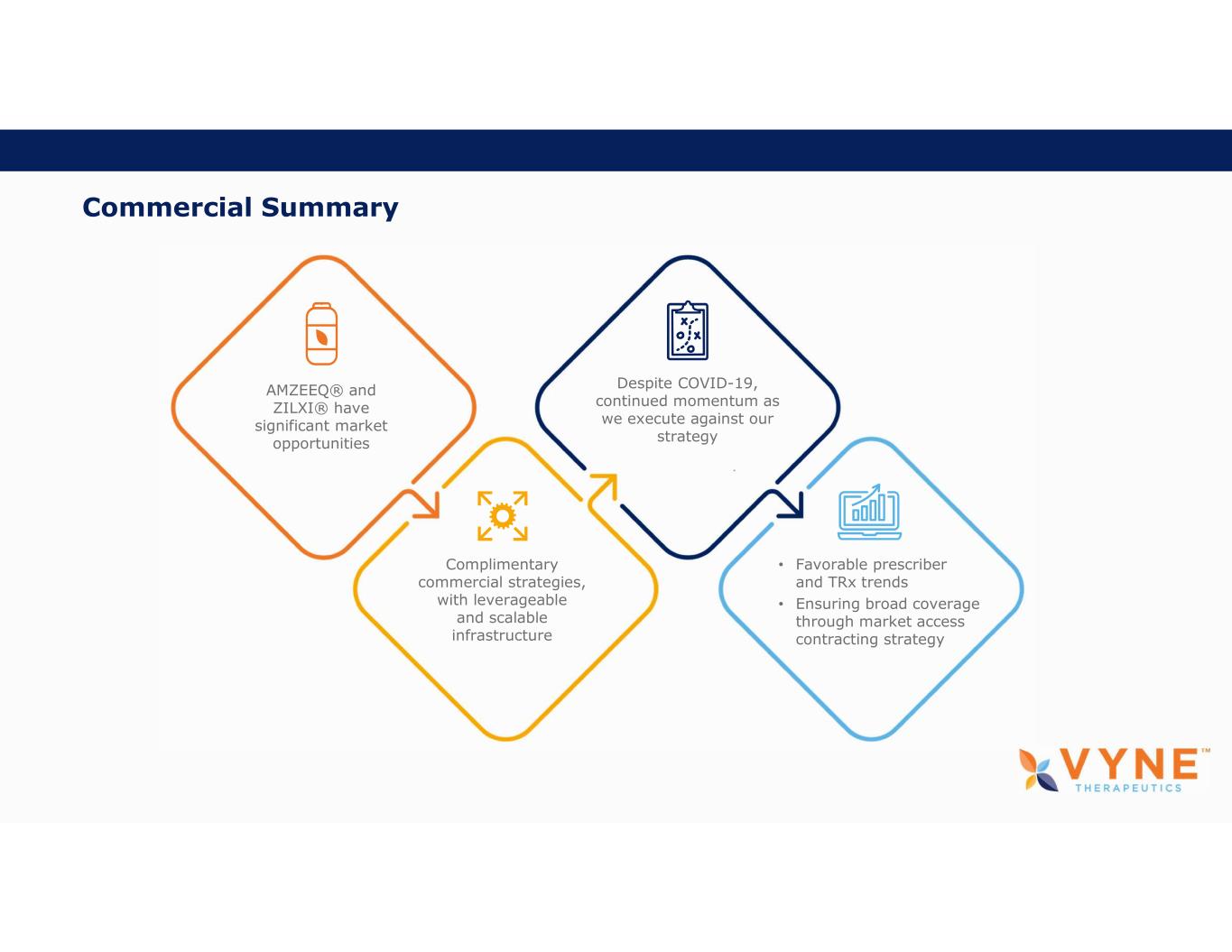
Commercial Summary AMZEEQ® and ZILXI® have significant market opportunities Despite COVID-19, continued momentum as we execute against our strategy Complimentary commercial strategies, with leverageable and scalable infrastructure • Favorable prescriber and TRx trends • Ensuring broad coverage through market access contracting strategy

PIPELINE OPPORTUNITIES 21
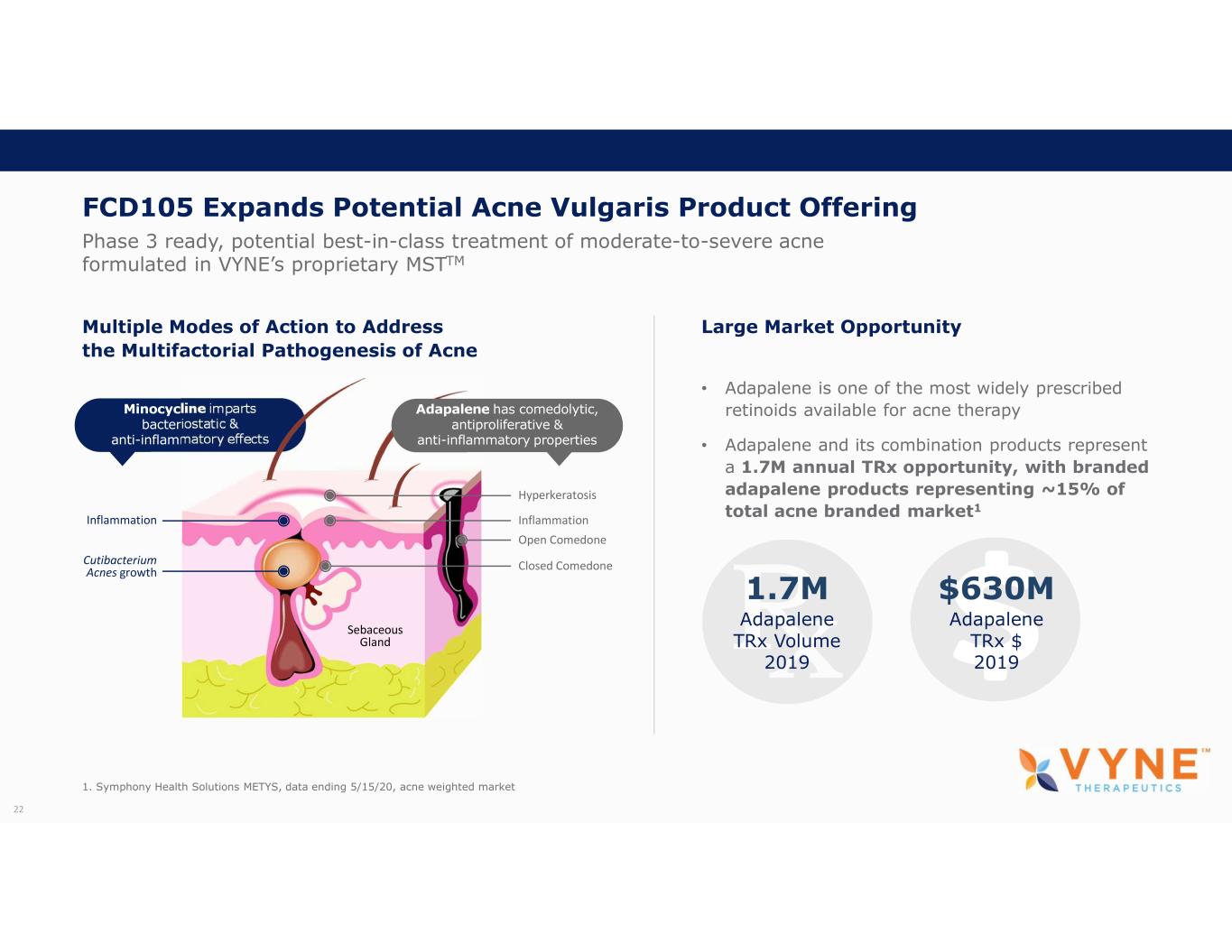
FCD105 Expands Potential Acne Vulgaris Product Offering Phase 3 ready, potential best-in-class treatment of moderate-to-severe acne formulated in VYNE’s proprietary MSTTM 22 1. Symphony Health Solutions METYS, data ending 5/15/20, acne weighted market Multiple Modes of Action to Address the Multifactorial Pathogenesis of Acne Large Market Opportunity • Adapalene is one of the most widely prescribed retinoids available for acne therapy • Adapalene and its combination products represent a 1.7M annual TRx opportunity, with branded adapalene products representing ~15% of total acne branded market1 1.7M Adapalene TRx Volume 2019 $630M Adapalene TRx $ 2019 Minocycline imparts bacteriostatic & anti-inflammatory effects Cutibacterium Acnes growth Inflammation Open Comedone Inflammation Closed Comedone Sebaceous Gland Hyperkeratosis Adapalene has comedolytic, antiproliferative & anti-inflammatory properties
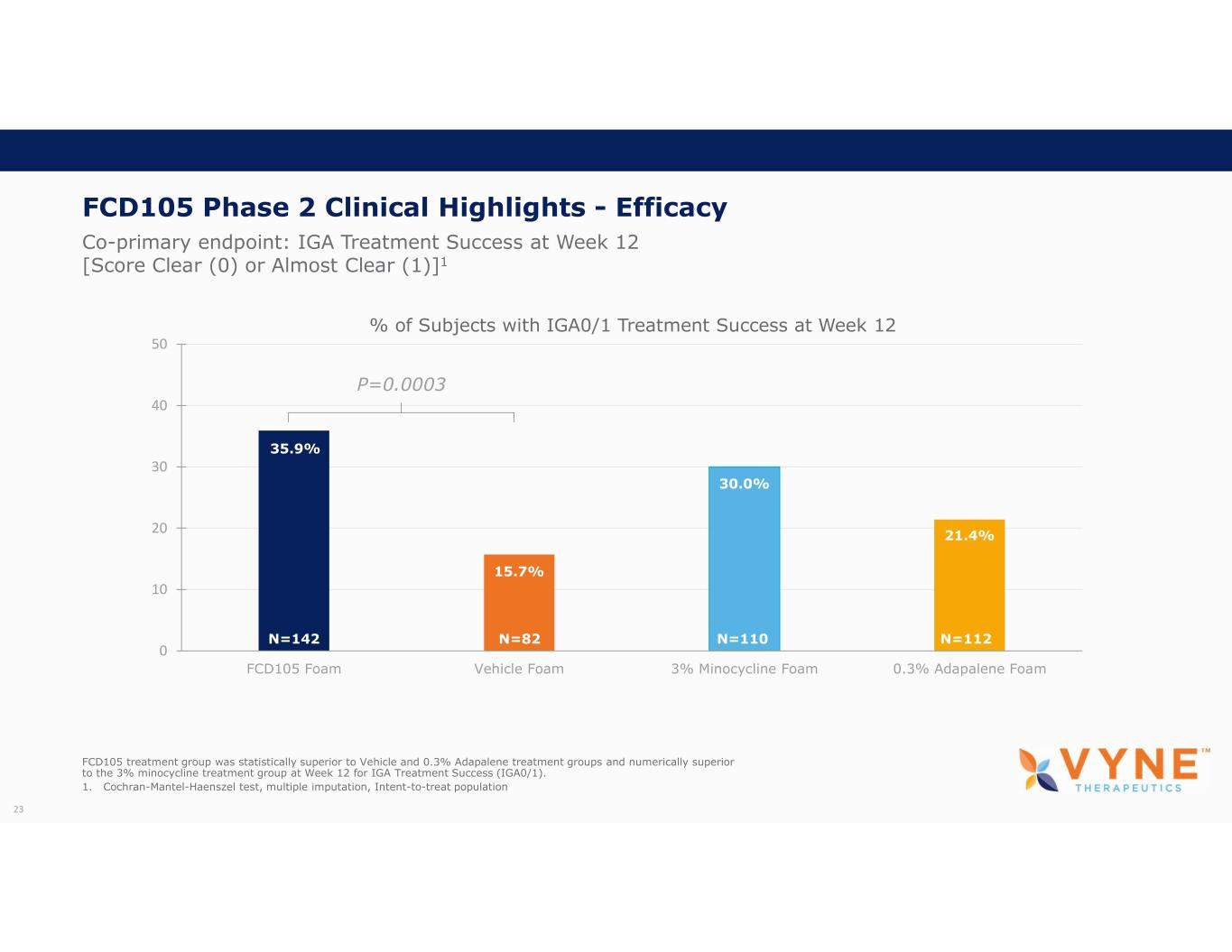
FCD105 Phase 2 Clinical Highlights - Efficacy Co-primary endpoint: IGA Treatment Success at Week 12 [Score Clear (0) or Almost Clear (1)]1 FCD105 treatment group was statistically superior to Vehicle and 0.3% Adapalene treatment groups and numerically superior to the 3% minocycline treatment group at Week 12 for IGA Treatment Success (IGA0/1). 1. Cochran-Mantel-Haenszel test, multiple imputation, Intent-to-treat population 23 35.9% 15.7% 30.0% 21.4% 0 10 20 30 40 50 FCD105 Foam Vehicle Foam 3% Minocycline Foam 0.3% Adapalene Foam P=0.0003 N=142 N=82 N=110 N=112 % of Subjects with IGA0/1 Treatment Success at Week 12
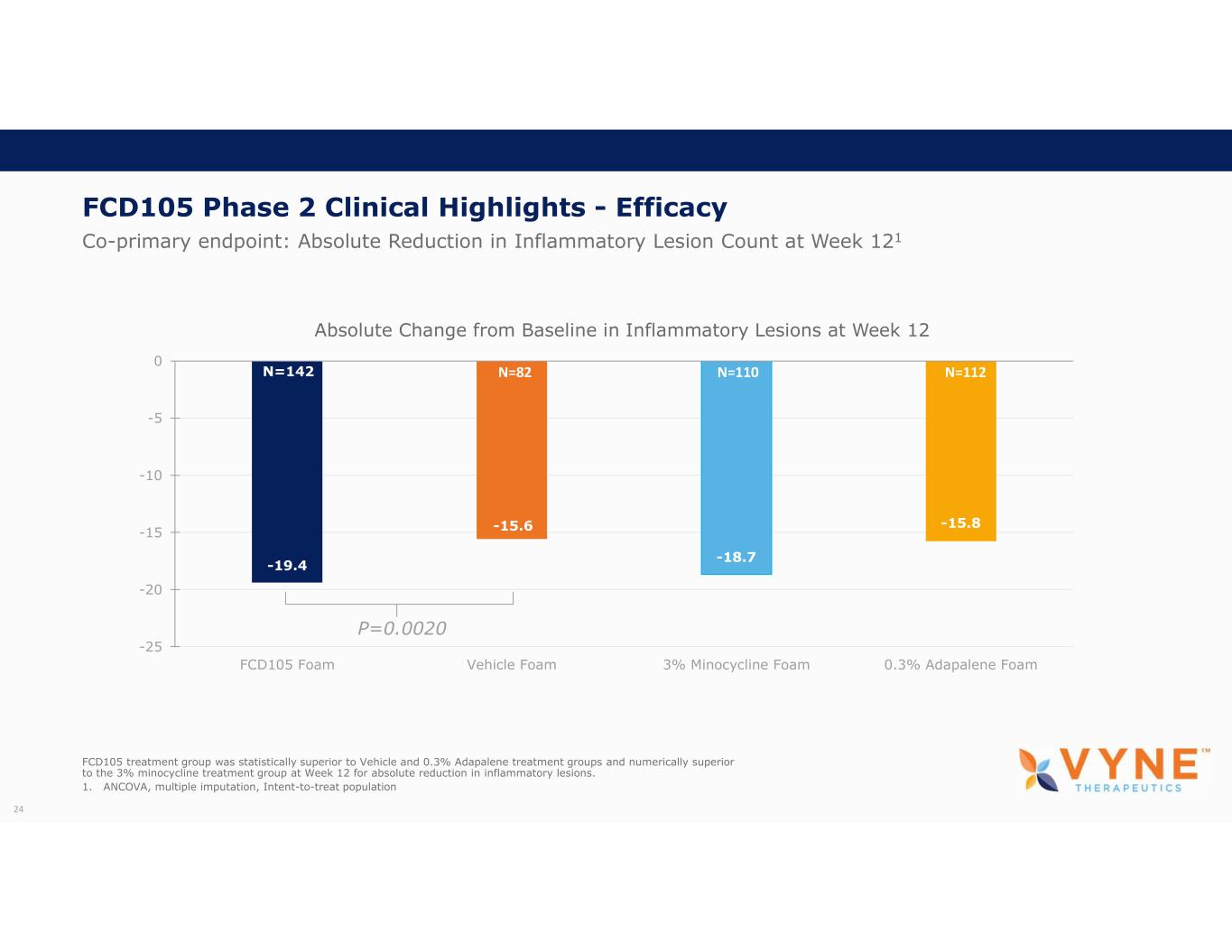
FCD105 Phase 2 Clinical Highlights - Efficacy Co-primary endpoint: Absolute Reduction in Inflammatory Lesion Count at Week 121 FCD105 treatment group was statistically superior to Vehicle and 0.3% Adapalene treatment groups and numerically superior to the 3% minocycline treatment group at Week 12 for absolute reduction in inflammatory lesions. 1. ANCOVA, multiple imputation, Intent-to-treat population 24 -19.4 -15.6 -18.7 -15.8 -25 -20 -15 -10 -5 0 FCD105 Foam Vehicle Foam 3% Minocycline Foam 0.3% Adapalene Foam P=0.0020 N=82 N=110 N=112N=142 Absolute Change from Baseline in Inflammatory Lesions at Week 12
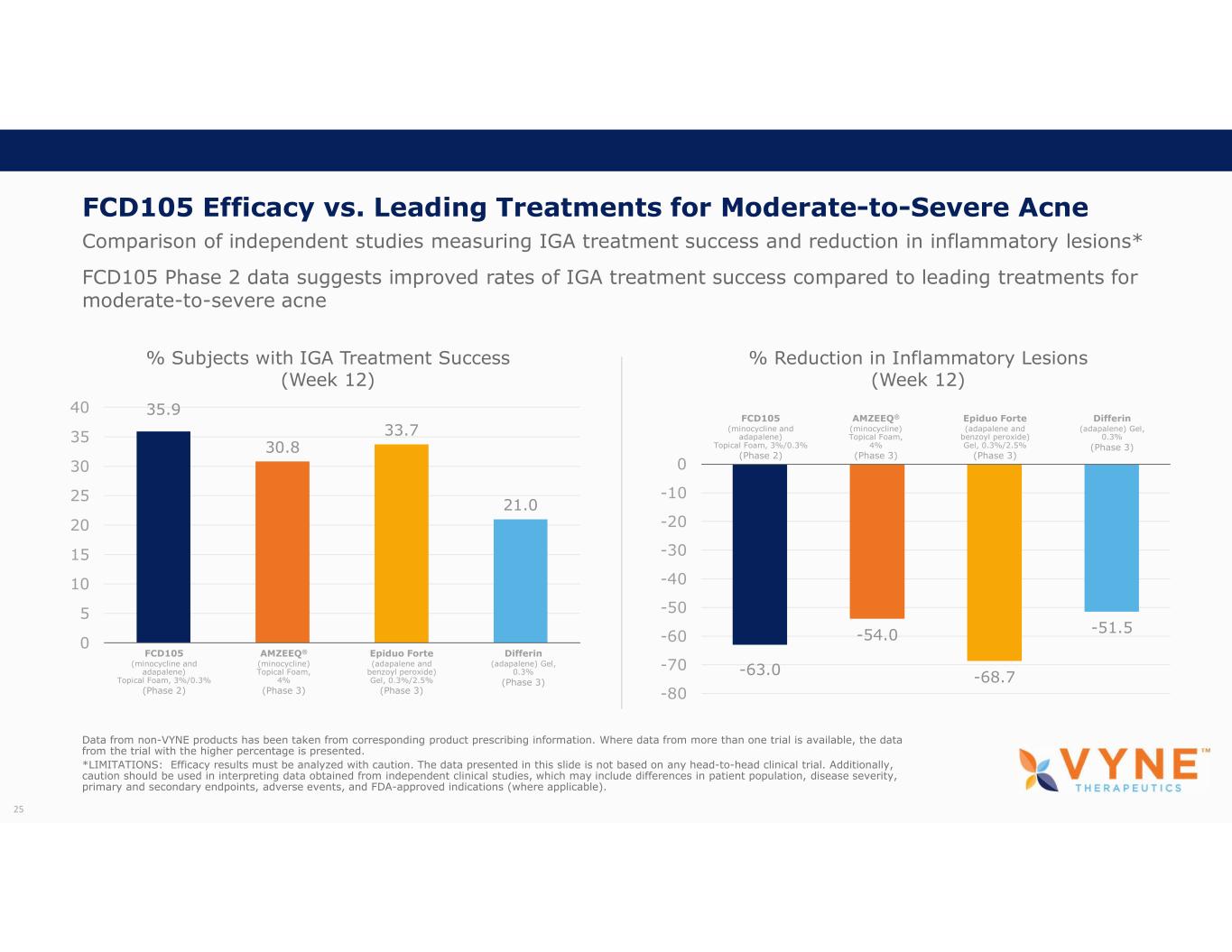
FCD105 Efficacy vs. Leading Treatments for Moderate-to-Severe Acne Comparison of independent studies measuring IGA treatment success and reduction in inflammatory lesions* FCD105 Phase 2 data suggests improved rates of IGA treatment success compared to leading treatments for moderate-to-severe acne Data from non-VYNE products has been taken from corresponding product prescribing information. Where data from more than one trial is available, the data from the trial with the higher percentage is presented. *LIMITATIONS: Efficacy results must be analyzed with caution. The data presented in this slide is not based on any head-to-head clinical trial. Additionally, caution should be used in interpreting data obtained from independent clinical studies, which may include differences in patient population, disease severity, primary and secondary endpoints, adverse events, and FDA-approved indications (where applicable). 25 35.9 30.8 33.7 21.0 0 5 10 15 20 25 30 35 40 % Subjects with IGA Treatment Success (Week 12) FCD105 (minocycline and adapalene) Topical Foam, 3%/0.3% (Phase 2) Epiduo Forte (adapalene and benzoyl peroxide) Gel, 0.3%/2.5% (Phase 3) Differin (adapalene) Gel, 0.3% (Phase 3) AMZEEQ® (minocycline) Topical Foam, 4% (Phase 3) -63.0 -54.0 -68.7 -51.5 -80 -70 -60 -50 -40 -30 -20 -10 0 % Reduction in Inflammatory Lesions (Week 12) FCD105 (minocycline and adapalene) Topical Foam, 3%/0.3% (Phase 2) Epiduo Forte (adapalene and benzoyl peroxide) Gel, 0.3%/2.5% (Phase 3) Differin (adapalene) Gel, 0.3% (Phase 3) AMZEEQ® (minocycline) Topical Foam, 4% (Phase 3)

FCD105 Phase 2 Clinical Highlights - Safety Summary of TEAEs in > 2 subjects (any treatment group) in descending order of frequency • Overall, TEAEs were few in type and frequency. All resolved prior to study completion. • There were no reported TESAEs during the conduct of the study. • ≥ 93% of subjects receiving FCD105 had local skin tolerability severity scores of none or mild at Week 12.* *Assessments included burning/stinging, itching, dryness, scaling, erythema and hyperpigmentation 26 System Organ Class / Preferred Term FCD105 Foam (N=142) 3% Minocycline Foam (N=110) 0.3% Adapalene Foam (N=112) Vehicle Foam (N=82) Total (N=446) Infections & infestations/Upper respiratory tract infection 2 (1.4) 3 (2.7) 1 (0.9) 4 (4.9) 10 (2.2) Nervous system disorders/Headache 1 (0.7) 2 (1.8) 2 (1.8) 3 (3.7) 8 (1.8) Skin and subcutaneous tissue disorders/Dry skin 2 (1.4) 1 (0.9) 4 (3.6) 0 (0.0) 7 (1.6) Infections and infestations/Nasopharyngitis 2 (1.4) 3 (2.7) 0 (0.0) 0 (0.0) 4 (1.1)
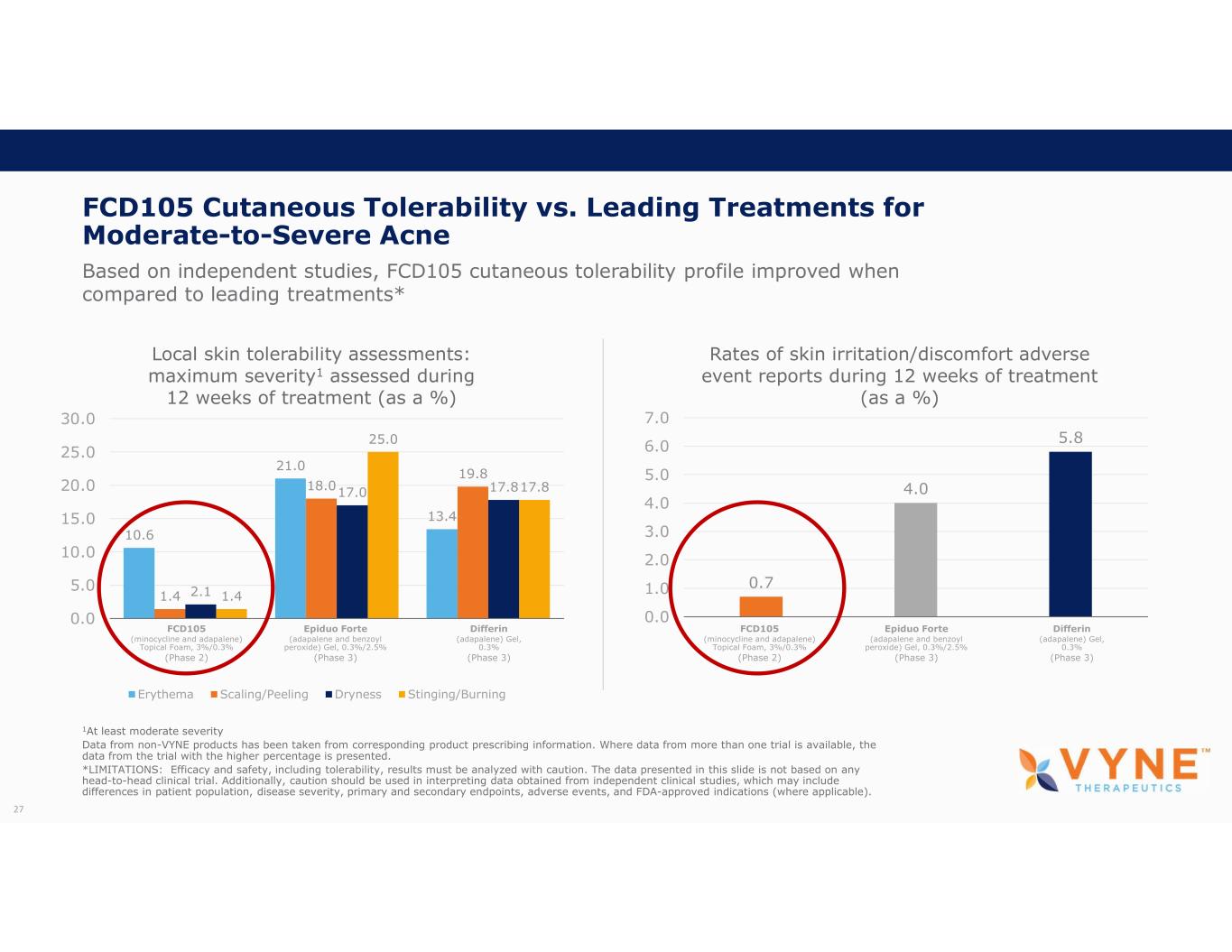
FCD105 Cutaneous Tolerability vs. Leading Treatments for Moderate-to-Severe Acne Based on independent studies, FCD105 cutaneous tolerability profile improved when compared to leading treatments* 1At least moderate severity Data from non-VYNE products has been taken from corresponding product prescribing information. Where data from more than one trial is available, the data from the trial with the higher percentage is presented. *LIMITATIONS: Efficacy and safety, including tolerability, results must be analyzed with caution. The data presented in this slide is not based on any head-to-head clinical trial. Additionally, caution should be used in interpreting data obtained from independent clinical studies, which may include differences in patient population, disease severity, primary and secondary endpoints, adverse events, and FDA-approved indications (where applicable). 27 10.6 21.0 13.4 1.4 18.0 19.8 2.1 17.0 17.8 1.4 25.0 17.8 0.0 5.0 10.0 15.0 20.0 25.0 30.0 Local skin tolerability assessments: maximum severity1 assessed during 12 weeks of treatment (as a %) Erythema Scaling/Peeling Dryness Stinging/Burning FCD105 (minocycline and adapalene) Topical Foam, 3%/0.3% (Phase 2) Epiduo Forte (adapalene and benzoyl peroxide) Gel, 0.3%/2.5% (Phase 3) Differin (adapalene) Gel, 0.3% (Phase 3) 0.7 4.0 5.8 0.0 1.0 2.0 3.0 4.0 5.0 6.0 7.0 Rates of skin irritation/discomfort adverse event reports during 12 weeks of treatment (as a %) FCD105 (minocycline and adapalene) Topical Foam, 3%/0.3% (Phase 2) Epiduo Forte (adapalene and benzoyl peroxide) Gel, 0.3%/2.5% (Phase 3) Differin (adapalene) Gel, 0.3% (Phase 3)
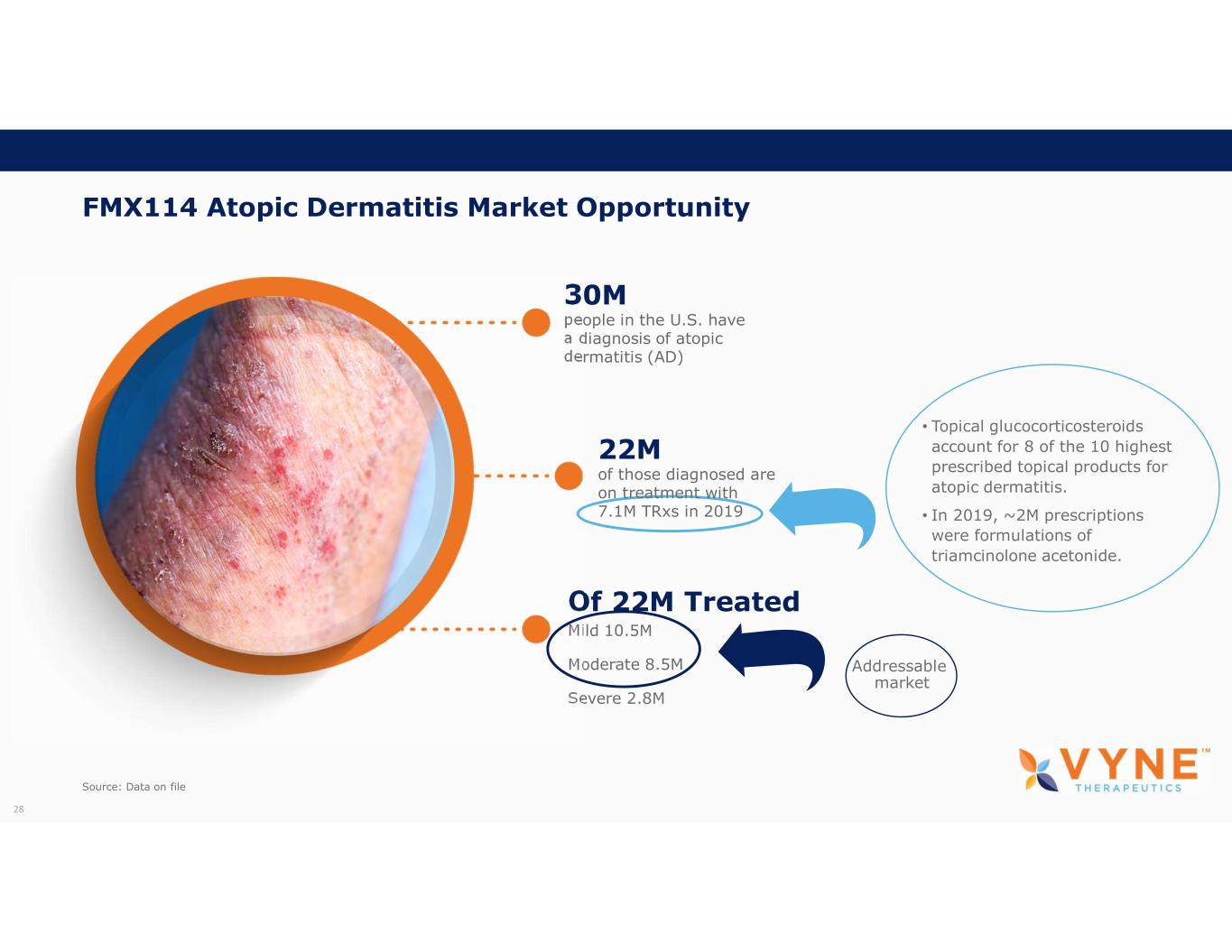
FMX114 Atopic Dermatitis Market Opportunity Source: Data on file 28 • Topical glucocorticosteroids account for 8 of the 10 highest prescribed topical products for atopic dermatitis. • In 2019, ~2M prescriptions were formulations of triamcinolone acetonide. Of 22M Treated Mild 10.5M Moderate 8.5M Severe 2.8M Addressable market 30M people in the U.S. have a diagnosis of atopic dermatitis (AD) 22M of those diagnosed are on treatment with 7.1M TRxs in 2019
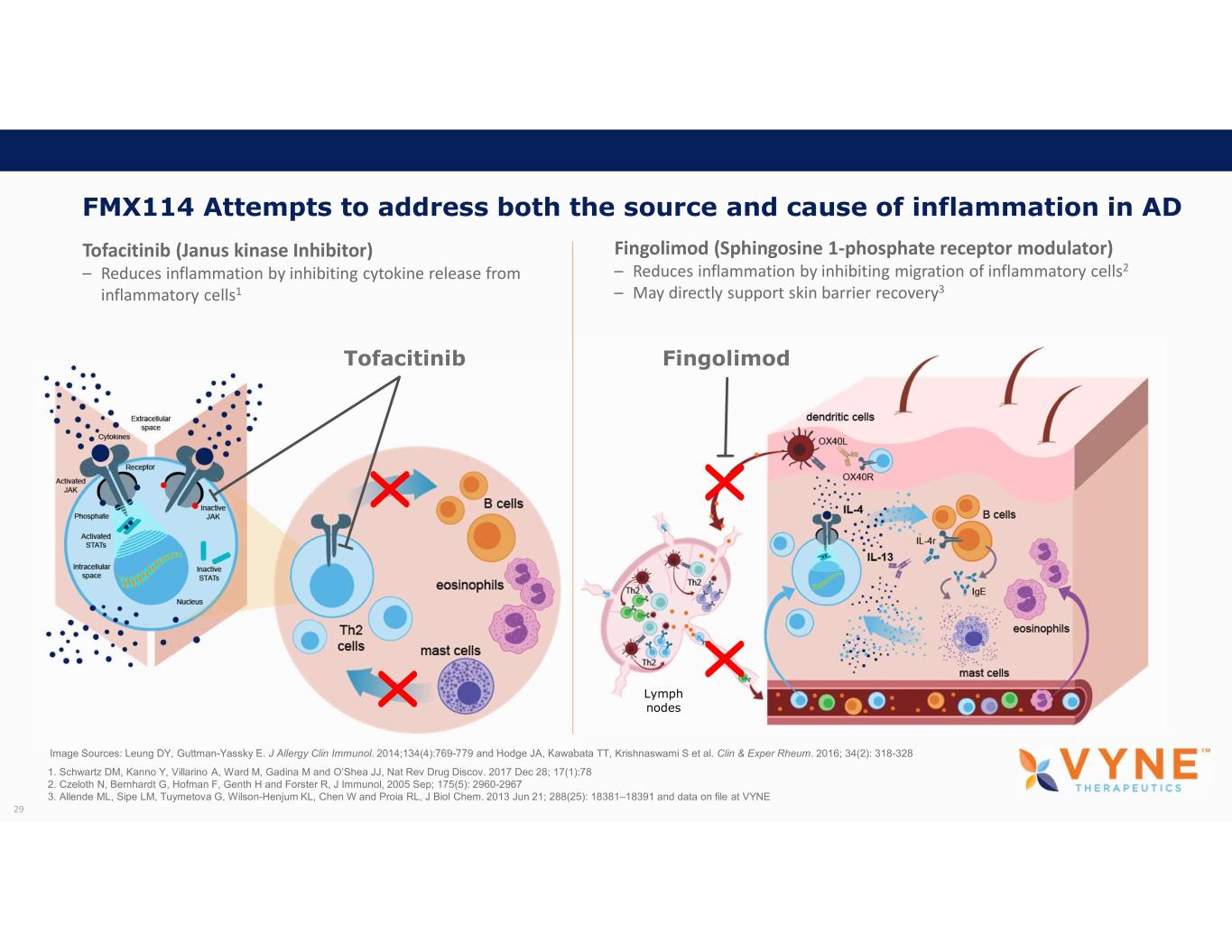
29 FMX114 Attempts to address both the source and cause of inflammation in AD Image Sources: Leung DY, Guttman-Yassky E. J Allergy Clin Immunol. 2014;134(4):769-779 and Hodge JA, Kawabata TT, Krishnaswami S et al. Clin & Exper Rheum. 2016; 34(2): 318-328 Fingolimod (Sphingosine 1-phosphate receptor modulator) – Reduces inflammation by inhibiting migration of inflammatory cells2 – May directly support skin barrier recovery3 Tofacitinib (Janus kinase Inhibitor) – Reduces inflammation by inhibiting cytokine release from inflammatory cells1 FingolimodTofacitinib Lymph nodes 1. Schwartz DM, Kanno Y, Villarino A, Ward M, Gadina M and O’Shea JJ, Nat Rev Drug Discov. 2017 Dec 28; 17(1):78 2. Czeloth N, Bernhardt G, Hofman F, Genth H and Forster R, J Immunol, 2005 Sep; 175(5): 2960-2967 3. Allende ML, Sipe LM, Tuymetova G, Wilson-Henjum KL, Chen W and Proia RL, J Biol Chem. 2013 Jun 21; 288(25): 18381–18391 and data on file at VYNE

FMX114 Nonclinical Efficacy and Tolerance From a DNCB Induction Murine AD model: Modified Atopic Dermatitis Index (mADI*) Dorsal depilated BALB-C mice were dosed for 39 days with 100µl topical DNCB solution (Day 1-32 induction phase, Day 32-38 treatment phase). N=8 animals were assigned to 7 treatment groups with each group receiving 100mg of allocated treatment once daily • Both tofacitinib and fingolimod monotherapy gels independently reduced mADI. • There was an 89% reduction in mADI for FMX114 relative to the DNCB control group at Day 7. • Both fixed combinations of FMX114 had comparable efficacy to triamcinolone 0.1% cream. DNCB – Dinitrochlorobenzene. *mADI is a composite mean score of erythema, excoriation/erosion and xerosis/peeling severity scored on a 4-point ordinal scale per domain (0=none, 1=mild, 2=moderate and 3=severe for a maximum score of 9), data expressed as a mean percentage change from initiation of treatment phase. 30 0 10 20 30 40 50 60 70 80 90 100 110 120 130 140 0 1 2 3 4 5 6 7 M e a n p e rc e n t ch a n g e i n m A D I Mean percent change in mADI DNCB control Tofacitinib 0.6%, Fingolimod 0.01% gel Tofacitinb 0.3%, Fingolimod 0.02% gel Tofacitinib 0.3% gel Fingolimod 0.01% gel Triamcinolone 0.1% cream 89%
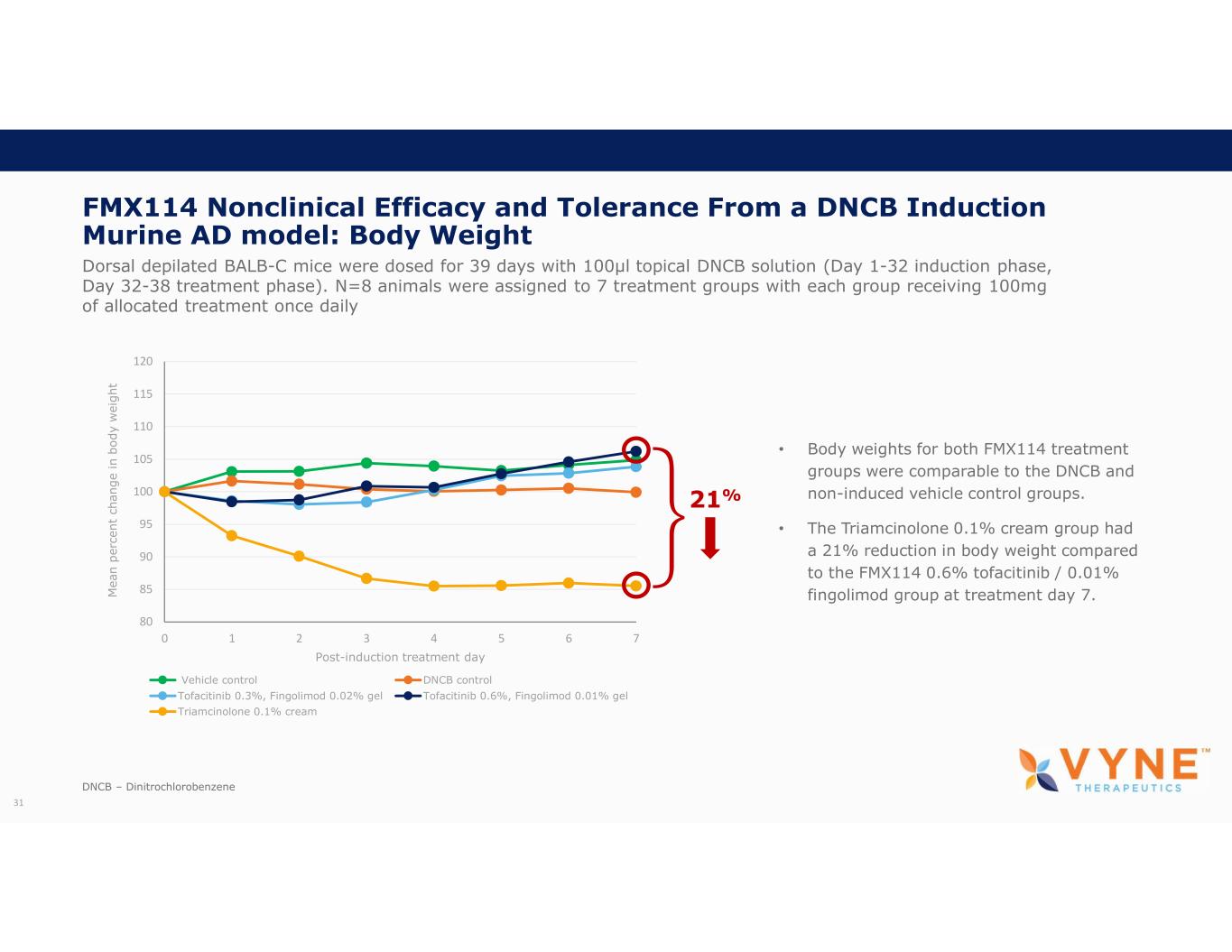
31 80 85 90 95 100 105 110 115 120 0 1 2 3 4 5 6 7 M e a n p e rc e n t ch a n g e i n b o d y w e ig h t Post-induction treatment day Vehicle control DNCB control Tofacitinib 0.3%, Fingolimod 0.02% gel Tofacitinib 0.6%, Fingolimod 0.01% gel Triamcinolone 0.1% cream 21% FMX114 Nonclinical Efficacy and Tolerance From a DNCB Induction Murine AD model: Body Weight Dorsal depilated BALB-C mice were dosed for 39 days with 100µl topical DNCB solution (Day 1-32 induction phase, Day 32-38 treatment phase). N=8 animals were assigned to 7 treatment groups with each group receiving 100mg of allocated treatment once daily • Body weights for both FMX114 treatment groups were comparable to the DNCB and non-induced vehicle control groups. • The Triamcinolone 0.1% cream group had a 21% reduction in body weight compared to the FMX114 0.6% tofacitinib / 0.01% fingolimod group at treatment day 7. DNCB – Dinitrochlorobenzene
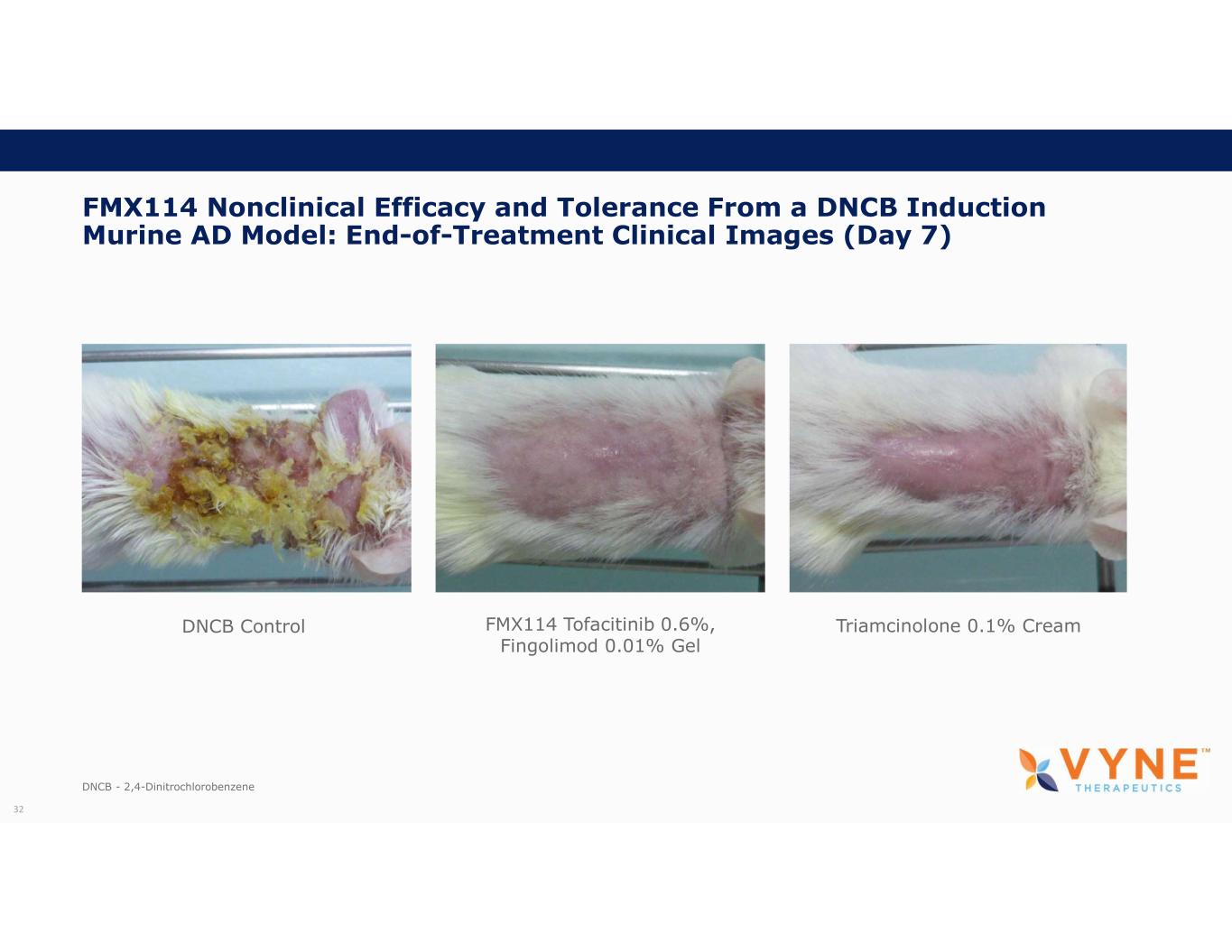
FMX114 Nonclinical Efficacy and Tolerance From a DNCB Induction Murine AD Model: End-of-Treatment Clinical Images (Day 7) DNCB - 2,4-Dinitrochlorobenzene 32 FMX114 Tofacitinib 0.6%, Fingolimod 0.01% Gel DNCB Control Triamcinolone 0.1% Cream
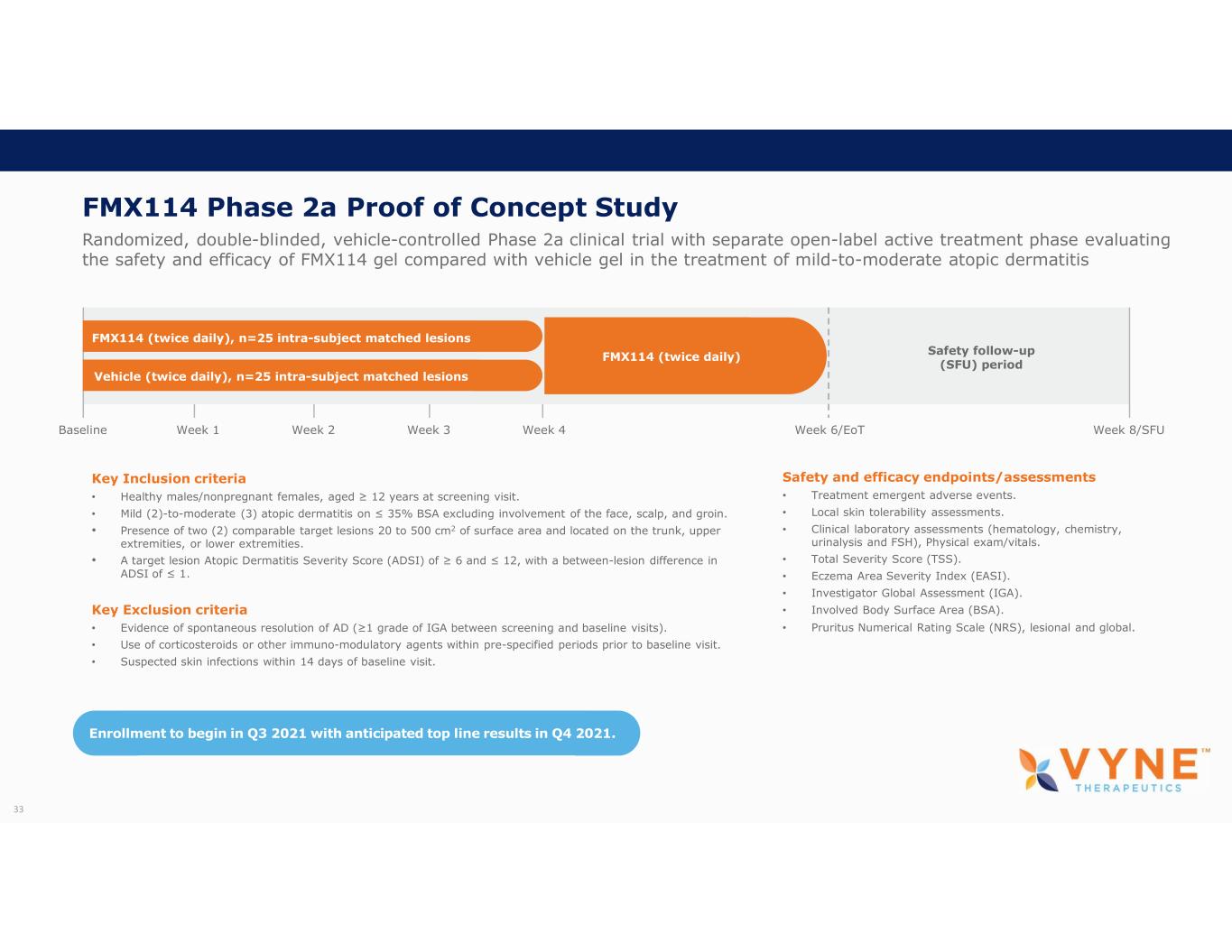
FMX114 Phase 2a Proof of Concept Study Randomized, double-blinded, vehicle-controlled Phase 2a clinical trial with separate open-label active treatment phase evaluating the safety and efficacy of FMX114 gel compared with vehicle gel in the treatment of mild-to-moderate atopic dermatitis 33 Baseline Week 1 FMX114 (twice daily), n=25 intra-subject matched lesions Week 4 Week 6/EoT Week 8/SFU Vehicle (twice daily), n=25 intra-subject matched lesions FMX114 (twice daily) Safety follow-up (SFU) period Key Inclusion criteria • Healthy males/nonpregnant females, aged ≥ 12 years at screening visit. • Mild (2)-to-moderate (3) atopic dermatitis on ≤ 35% BSA excluding involvement of the face, scalp, and groin. • Presence of two (2) comparable target lesions 20 to 500 cm2 of surface area and located on the trunk, upper extremities, or lower extremities. • A target lesion Atopic Dermatitis Severity Score (ADSI) of ≥ 6 and ≤ 12, with a between-lesion difference in ADSI of ≤ 1. Key Exclusion criteria • Evidence of spontaneous resolution of AD (≥1 grade of IGA between screening and baseline visits). • Use of corticosteroids or other immuno-modulatory agents within pre-specified periods prior to baseline visit. • Suspected skin infections within 14 days of baseline visit. Safety and efficacy endpoints/assessments • Treatment emergent adverse events. • Local skin tolerability assessments. • Clinical laboratory assessments (hematology, chemistry, urinalysis and FSH), Physical exam/vitals. • Total Severity Score (TSS). • Eczema Area Severity Index (EASI). • Investigator Global Assessment (IGA). • Involved Body Surface Area (BSA). • Pruritus Numerical Rating Scale (NRS), lesional and global. Enrollment to begin in Q3 2021 with anticipated top line results in Q4 2021. Week 2 Week 3 FMX114 (twice daily), n=25 intra-subject matched lesions Vehicl (twice daily), n=25 intra-subject ma ched lesion FMX114 (twice daily) f t f ll - ( ) ri

Well Positioned To Deliver Significant Value Focused approach for 2021 Commercial Execution Maximize Operational Leverage Build a Diversified Portfolio and Pipeline 34 Long-term Value
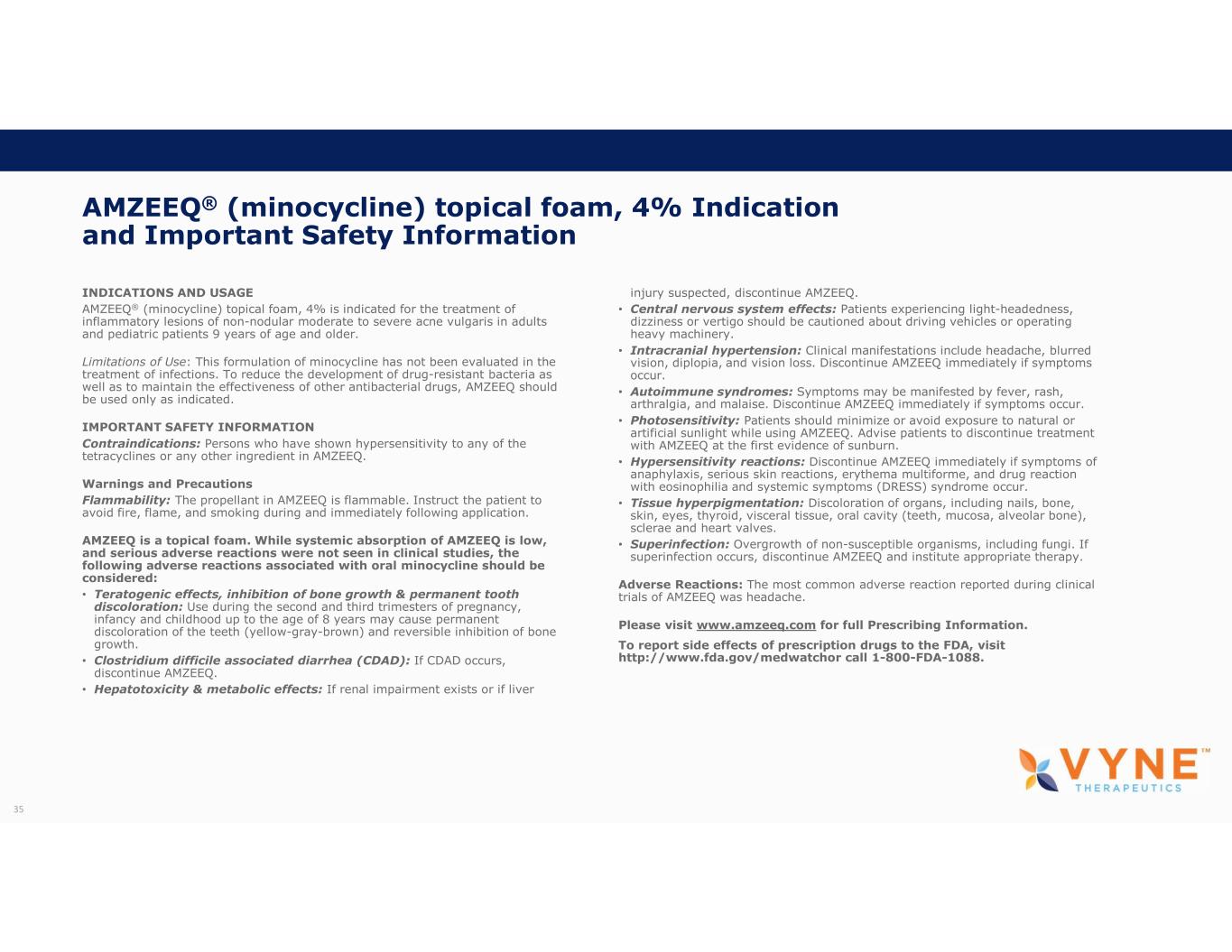
AMZEEQ® (minocycline) topical foam, 4% Indication and Important Safety Information 35 INDICATIONS AND USAGE AMZEEQ® (minocycline) topical foam, 4% is indicated for the treatment of inflammatory lesions of non-nodular moderate to severe acne vulgaris in adults and pediatric patients 9 years of age and older. Limitations of Use: This formulation of minocycline has not been evaluated in the treatment of infections. To reduce the development of drug-resistant bacteria as well as to maintain the effectiveness of other antibacterial drugs, AMZEEQ should be used only as indicated. IMPORTANT SAFETY INFORMATION Contraindications: Persons who have shown hypersensitivity to any of the tetracyclines or any other ingredient in AMZEEQ. Warnings and Precautions Flammability: The propellant in AMZEEQ is flammable. Instruct the patient to avoid fire, flame, and smoking during and immediately following application. AMZEEQ is a topical foam. While systemic absorption of AMZEEQ is low, and serious adverse reactions were not seen in clinical studies, the following adverse reactions associated with oral minocycline should be considered: • Teratogenic effects, inhibition of bone growth & permanent tooth discoloration: Use during the second and third trimesters of pregnancy, infancy and childhood up to the age of 8 years may cause permanent discoloration of the teeth (yellow-gray-brown) and reversible inhibition of bone growth. • Clostridium difficile associated diarrhea (CDAD): If CDAD occurs, discontinue AMZEEQ. • Hepatotoxicity & metabolic effects: If renal impairment exists or if liver injury suspected, discontinue AMZEEQ. • Central nervous system effects: Patients experiencing light-headedness, dizziness or vertigo should be cautioned about driving vehicles or operating heavy machinery. • Intracranial hypertension: Clinical manifestations include headache, blurred vision, diplopia, and vision loss. Discontinue AMZEEQ immediately if symptoms occur. • Autoimmune syndromes: Symptoms may be manifested by fever, rash, arthralgia, and malaise. Discontinue AMZEEQ immediately if symptoms occur. • Photosensitivity: Patients should minimize or avoid exposure to natural or artificial sunlight while using AMZEEQ. Advise patients to discontinue treatment with AMZEEQ at the first evidence of sunburn. • Hypersensitivity reactions: Discontinue AMZEEQ immediately if symptoms of anaphylaxis, serious skin reactions, erythema multiforme, and drug reaction with eosinophilia and systemic symptoms (DRESS) syndrome occur. • Tissue hyperpigmentation: Discoloration of organs, including nails, bone, skin, eyes, thyroid, visceral tissue, oral cavity (teeth, mucosa, alveolar bone), sclerae and heart valves. • Superinfection: Overgrowth of non-susceptible organisms, including fungi. If superinfection occurs, discontinue AMZEEQ and institute appropriate therapy. Adverse Reactions: The most common adverse reaction reported during clinical trials of AMZEEQ was headache. Please visit www.amzeeq.com for full Prescribing Information. To report side effects of prescription drugs to the FDA, visit http://www.fda.gov/medwatchor call 1-800-FDA-1088.
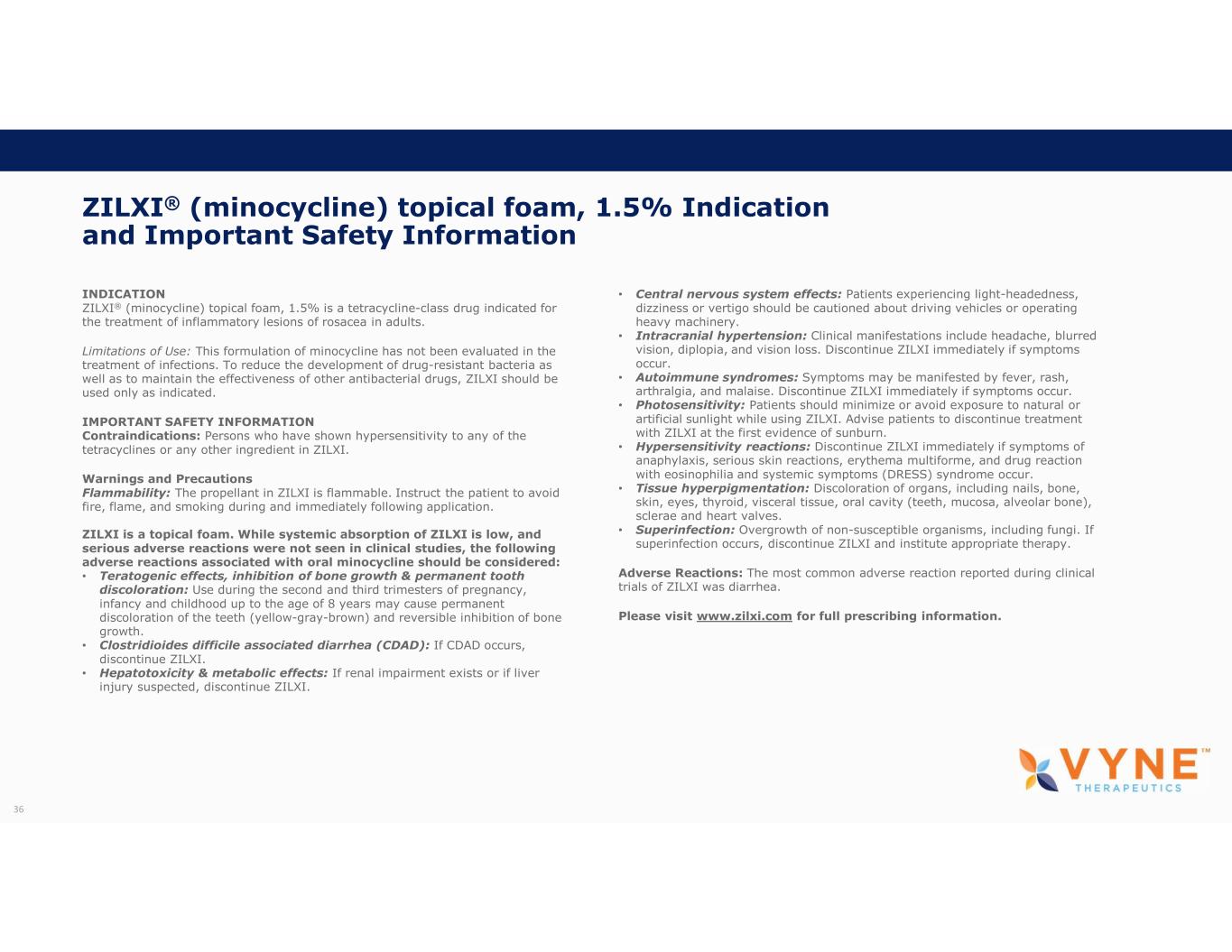
ZILXI® (minocycline) topical foam, 1.5% Indication and Important Safety Information 36 INDICATION ZILXI® (minocycline) topical foam, 1.5% is a tetracycline-class drug indicated for the treatment of inflammatory lesions of rosacea in adults. Limitations of Use: This formulation of minocycline has not been evaluated in the treatment of infections. To reduce the development of drug-resistant bacteria as well as to maintain the effectiveness of other antibacterial drugs, ZILXI should be used only as indicated. IMPORTANT SAFETY INFORMATION Contraindications: Persons who have shown hypersensitivity to any of the tetracyclines or any other ingredient in ZILXI. Warnings and Precautions Flammability: The propellant in ZILXI is flammable. Instruct the patient to avoid fire, flame, and smoking during and immediately following application. ZILXI is a topical foam. While systemic absorption of ZILXI is low, and serious adverse reactions were not seen in clinical studies, the following adverse reactions associated with oral minocycline should be considered: • Teratogenic effects, inhibition of bone growth & permanent tooth discoloration: Use during the second and third trimesters of pregnancy, infancy and childhood up to the age of 8 years may cause permanent discoloration of the teeth (yellow-gray-brown) and reversible inhibition of bone growth. • Clostridioides difficile associated diarrhea (CDAD): If CDAD occurs, discontinue ZILXI. • Hepatotoxicity & metabolic effects: If renal impairment exists or if liver injury suspected, discontinue ZILXI. • Central nervous system effects: Patients experiencing light-headedness, dizziness or vertigo should be cautioned about driving vehicles or operating heavy machinery. • Intracranial hypertension: Clinical manifestations include headache, blurred vision, diplopia, and vision loss. Discontinue ZILXI immediately if symptoms occur. • Autoimmune syndromes: Symptoms may be manifested by fever, rash, arthralgia, and malaise. Discontinue ZILXI immediately if symptoms occur. • Photosensitivity: Patients should minimize or avoid exposure to natural or artificial sunlight while using ZILXI. Advise patients to discontinue treatment with ZILXI at the first evidence of sunburn. • Hypersensitivity reactions: Discontinue ZILXI immediately if symptoms of anaphylaxis, serious skin reactions, erythema multiforme, and drug reaction with eosinophilia and systemic symptoms (DRESS) syndrome occur. • Tissue hyperpigmentation: Discoloration of organs, including nails, bone, skin, eyes, thyroid, visceral tissue, oral cavity (teeth, mucosa, alveolar bone), sclerae and heart valves. • Superinfection: Overgrowth of non-susceptible organisms, including fungi. If superinfection occurs, discontinue ZILXI and institute appropriate therapy. Adverse Reactions: The most common adverse reaction reported during clinical trials of ZILXI was diarrhea. Please visit www.zilxi.com for full prescribing information.
